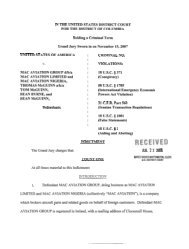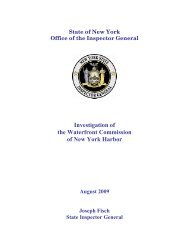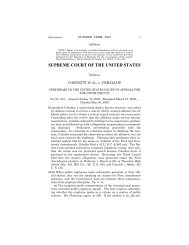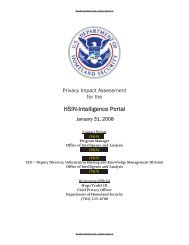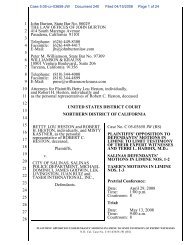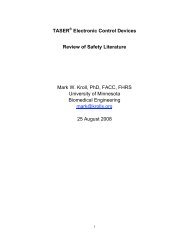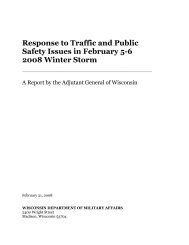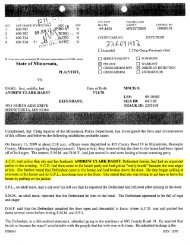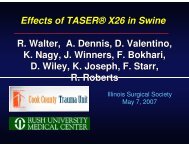Progress in Developing the National Asset Database
Progress in Developing the National Asset Database
Progress in Developing the National Asset Database
You also want an ePaper? Increase the reach of your titles
YUMPU automatically turns print PDFs into web optimized ePapers that Google loves.
DRAFTDEPARTMENT OF HOMELAND SECURITYOffice of Inspector General<strong>Progress</strong> <strong>in</strong> Develop<strong>in</strong>g<strong>the</strong><strong>National</strong> <strong>Asset</strong> <strong>Database</strong>Office of Inspections and Special ReviewsOIG-06-40FOR OFFICIAL USE ONLYJune 2006
Office of Inspector GeneralU.S. Department of Homeland SecurityWash<strong>in</strong>gton, DC 20528June 20, 2006PrefaceThe Department of Homeland Security (DHS) Office of Inspector General (OIG) was established by<strong>the</strong> Homeland Security Act of 2002 (Public Law 107-296) by amendment to <strong>the</strong> Inspector GeneralAct of 1978. This is one of a series of audit, <strong>in</strong>spection, and special reports prepared as part of ouroversight responsibility to promote economy, effectiveness, and efficiency with<strong>in</strong> <strong>the</strong> department.This report assesses <strong>the</strong> actions DHS has taken to identify and organize <strong>the</strong> nation’s critical<strong>in</strong>frastructure and key resources <strong>in</strong> <strong>the</strong> <strong>National</strong> <strong>Asset</strong> <strong>Database</strong>. It is based on <strong>in</strong>terviews wi<strong>the</strong>mployees and officials of relevant agencies and <strong>in</strong>stitutions, direct observations, and a review ofapplicable documents.The recommendations have been developed to <strong>the</strong> best knowledge available to <strong>the</strong> OIG, and havebeen discussed <strong>in</strong> draft with those responsible for implementation. It is our hope that this report willresult <strong>in</strong> more effective, efficient, and economical operations. We express our appreciation to all ofthose who contributed to <strong>the</strong> preparation of this report.Richard L. Sk<strong>in</strong>nerInspector General
ContentsExecutive Summary.............................................................................................................................. 1Background........................................................................................................................................... 2Results of Review ................................................................................................................................. 5Identification and Collection of Critical Infrastructure and Key Resource Information.......... 5Concerns About State-Identified <strong>Asset</strong>s ................................................................................... 9Prioritiz<strong>in</strong>g <strong>the</strong> <strong>National</strong> <strong>Asset</strong> <strong>Database</strong> ................................................................................ 16Enhanc<strong>in</strong>g Prioritization Capability.................................................................................................... 18Recommendations............................................................................................................................... 21Management Comments and OIG Analysis ....................................................................................... 21AppendicesAppendix A: Purpose, Scope, and Methodology.......................................................................26Appendix B: Preparedness Response to OIG ............................................................................28Appendix C: Roles and Responsibilities with<strong>in</strong> NIPP Risk Management Framework.............35Appendix D: Critical Infrastructure and Key Resource Sectors ................................................41Appendix E: Guidel<strong>in</strong>es for Identify<strong>in</strong>g <strong>National</strong> Level Critical Infrastructure and KeyResources .............................................................................................................42Appendix F: Critical Infrastructure/Key Resource Totals By State..........................................46Appendix G: Major Contributors to This Report.......................................................................48Appendix H: Report Distribution...............................................................................................49<strong>Progress</strong> <strong>in</strong> Develop<strong>in</strong>g <strong>the</strong> <strong>National</strong> <strong>Asset</strong> <strong>Database</strong>
AbbreviationsBZPP Buffer Zone Protection ProgramCI/KR Critical Infrastructure/Key ResourcesCIP-DSS Critical Infrastructure Protection-Decision Support SystemCOP Common Operational PictureGCOA Gross Consequences of AttackHITRAC Homeland Infrastructure Threat and Risk Analysis CenterHSA Homeland Security Act of 2002HSOC Homeland Security Operations CenterHSPD Homeland Security Presidential DirectiveIA Office of Intelligence and AnalysisIAIP Information Analysis and Infrastructure Protection DirectorateIP Office of Infrastructure ProtectionLNG Liquefied Natural GasNADB <strong>National</strong> <strong>Asset</strong> <strong>Database</strong>NICC <strong>National</strong> Infrastructure Coord<strong>in</strong>ation CenterNIPP <strong>National</strong> Infrastructure Protection PlanNISAC <strong>National</strong> Infrastructure Simulation and Analysis CenterNRC <strong>National</strong> Response CenterNSHS <strong>National</strong> Strategy for Homeland SecurityNSPP <strong>National</strong> Strategy for <strong>the</strong> Physical Protection of Critical Infrastructure and Key <strong>Asset</strong>sODP Office for Domestic PreparednessOIG Office of Inspector GeneralPCCIP President’s Commission on Critical Infrastructure ProtectionPCII Protected Critical Infrastructure Information ProgramPDD Presidential Decision DirectivePMTL Protective Measures Target ListRAMCAP Risk Analysis and Management for Critical <strong>Asset</strong> ProtectionRMD Risk Management DivisionSSA Sector Specific AgencyUASI Urban Area Security InitiativeUSCG United States Coast GuardUSACE United States Army Corps of Eng<strong>in</strong>eers<strong>Progress</strong> <strong>in</strong> Develop<strong>in</strong>g <strong>the</strong> <strong>National</strong> <strong>Asset</strong> <strong>Database</strong>
Executive SummaryOn December 17, 2003, President Bush released Homeland SecurityPresidential Directive No. 7, Critical Infrastructure Identification,Prioritization, and Protection - a national policy for federal departments andagencies to identify and prioritize <strong>the</strong> United States’ critical <strong>in</strong>frastructure andkey resources (CI/KR) and to protect <strong>the</strong>m from terrorist attacks. TheDepartment of Homeland Security (DHS) is responsible for establish<strong>in</strong>g <strong>the</strong>risk management framework necessary to coord<strong>in</strong>ate <strong>the</strong>se efforts. Thisframework requires <strong>the</strong> support of a comprehensive, national asset <strong>in</strong>ventory.DHS calls this <strong>in</strong>ventory <strong>the</strong> <strong>National</strong> <strong>Asset</strong> <strong>Database</strong> (NADB).DHS’ Office of Infrastructure Protection (IP) is still identify<strong>in</strong>g and collect<strong>in</strong>gCI/KR data, simultaneously populat<strong>in</strong>g <strong>the</strong> first-generation NADB, andbuild<strong>in</strong>g <strong>the</strong> next-generation NADB. As of January 2006, <strong>the</strong> NADBconta<strong>in</strong>ed 77,069 assets, which are not dist<strong>in</strong>guished by criticality. Only afterIP completes risk assessments of <strong>the</strong> assets will it have actual lists of CI/KR.None<strong>the</strong>less, <strong>the</strong> vary<strong>in</strong>g presence of non-critical assets - and <strong>the</strong>y are difficultto quantify – confirms that <strong>the</strong> NADB is not an accurate representation of <strong>the</strong>nation’s CI/KR. In addition, <strong>the</strong> NADB is not yet comprehensive enough tosupport <strong>the</strong> management and resource allocation decision-mak<strong>in</strong>g envisionedby <strong>the</strong> <strong>National</strong> Infrastructure Protection Plan (NIPP).IP has a substantial amount of work ahead to determ<strong>in</strong>e <strong>the</strong> ultimatedisposition of <strong>the</strong> NADB’s contents and each asset’s importance to <strong>the</strong>country. It is work<strong>in</strong>g on enhanc<strong>in</strong>g its ability to analyze and prioritize CI/KRdata but those efforts cont<strong>in</strong>ue to be affected by slow development of both <strong>the</strong>NADB and risk assessment tools. We cannot predict when IP will have both<strong>the</strong> data and <strong>the</strong> analytical tools to provide a comprehensive risk assessment of<strong>the</strong> country’s critical <strong>in</strong>frastructure and key resources.We are recommend<strong>in</strong>g four specific actions to <strong>the</strong> Under Secretary forPreparedness to improve <strong>the</strong> development and quality of <strong>the</strong> national assetdatabase.<strong>Progress</strong> <strong>in</strong> Develop<strong>in</strong>g <strong>the</strong> <strong>National</strong> <strong>Asset</strong> <strong>Database</strong>1
BackgroundIn 1998, President Cl<strong>in</strong>ton issued Presidential Decision Directive No. 63(PDD-63), Critical Infrastructure Protection, which set forth pr<strong>in</strong>ciples forprotect<strong>in</strong>g <strong>the</strong> nation by m<strong>in</strong>imiz<strong>in</strong>g <strong>the</strong> threat of smaller-scale terrorist attacksaga<strong>in</strong>st <strong>in</strong>formation technology and geographically-distributed supply cha<strong>in</strong>sthat could cascade and disrupt entire sectors of <strong>the</strong> economy. 1 Absent acentralized authority for homeland security, federal agencies were designatedas Lead Agencies <strong>in</strong> <strong>the</strong>ir sector of expertise. The Lead Agencies were taskedto develop sector-specific Information Shar<strong>in</strong>g and Analysis Centers tocoord<strong>in</strong>ate efforts with <strong>the</strong> private sector. PDD-63 required <strong>the</strong> creation of a<strong>National</strong> Infrastructure Assurance Plan.The present adm<strong>in</strong>istration was review<strong>in</strong>g this strategy when <strong>the</strong> terroristattacks of September 11, 2001, accelerated its implementation. It began toadapt and develop <strong>the</strong> pr<strong>in</strong>ciples of PDD-63. Executive Orders 13228 and13231 expanded <strong>the</strong> federal role as a coord<strong>in</strong>at<strong>in</strong>g partner for state and localagencies as well as <strong>the</strong> private sector, raised <strong>the</strong> priority of physical assets asdist<strong>in</strong>guished from cyber assets, and organized <strong>in</strong>frastructure coord<strong>in</strong>ationthrough <strong>the</strong> creation of <strong>the</strong> <strong>National</strong> Infrastructure Advisory Council, <strong>the</strong>Homeland Security Council, and <strong>the</strong> Office of Homeland Security. 2In July 2002, <strong>the</strong> White House Office of Homeland Security released <strong>the</strong><strong>National</strong> Strategy for Homeland Security (NSHS). Protect<strong>in</strong>g <strong>the</strong> nation’scritical <strong>in</strong>frastructure and key assets was one of its six critical mission areas. 3Critical <strong>in</strong>frastructure was previously def<strong>in</strong>ed as “systems and assets, whe<strong>the</strong>rphysical or virtual, so vital to <strong>the</strong> United States that <strong>the</strong> <strong>in</strong>capacity ordestruction of such systems and assets would have a debilitat<strong>in</strong>g impact onsecurity, national economic security, national public health or safety, or anycomb<strong>in</strong>ation of those matters….” 4 The NSHS adds to this concept a concernfor key assets, “<strong>in</strong>dividual targets whose destruction would not endanger vitalsystems, but could create local disaster or profoundly damage our Nation’smorale or confidence. Key assets <strong>in</strong>clude symbols or historical attractions,1 Presidential Decision Directive 63: Critical Infrastructure Protection, May 22, 1998. Executive Order 13010: CriticalInfrastructure Protection, established <strong>the</strong> President’s Commission on Critical Infrastructure Protection (PCCIP). FederalRegister Vol. 61, No. 138, July 17, 1996, pp. 37347-37350. PCCIP fostered <strong>the</strong> development of PDD-63.2 Executive Order 13228: Establish<strong>in</strong>g <strong>the</strong> Office of Homeland Security and <strong>the</strong> Homeland Security Council, Vol. 66,No. 196, Oct. 10, 2001. pp. 51812-51817. Executive Order 13231: Critical Infrastructure Protection <strong>in</strong> <strong>the</strong> InformationAge. Federal Register. Vol. 66, No. 202. Oct. 18, 2001. pp. 53063-53071.3 <strong>National</strong> Strategy for Homeland Security, pp. viii, 29-36.4 USA PATRIOT Act, P.L. 107-56 Sec. 1016(e).<strong>Progress</strong> <strong>in</strong> Develop<strong>in</strong>g <strong>the</strong> <strong>National</strong> <strong>Asset</strong> <strong>Database</strong>2
such as prom<strong>in</strong>ent national, state, or local monuments and icons.” 5 Thisdiffers slightly from <strong>the</strong> term “key resources,” def<strong>in</strong>ed <strong>in</strong> <strong>the</strong> HomelandSecurity Act of 2002 (HSA) as “publicly or privately controlled resourcesessential to <strong>the</strong> m<strong>in</strong>imal operations of <strong>the</strong> economy and government.” 6 TheNSHS cont<strong>in</strong>ued <strong>the</strong> concept of lead agencies—now called Sector-SpecificAgencies (SSAs)—but designated <strong>the</strong> yet-to-be-created DHS to coord<strong>in</strong>ate <strong>the</strong>strategy as well as be <strong>the</strong> lead agency for some sectors. It def<strong>in</strong>ed eight major<strong>in</strong>itiatives <strong>in</strong> protect<strong>in</strong>g critical <strong>in</strong>frastructure and key assets, <strong>in</strong>clud<strong>in</strong>g“[b]uild[<strong>in</strong>g] and ma<strong>in</strong>ta<strong>in</strong>[<strong>in</strong>g] a complete assessment of America’s critical<strong>in</strong>frastructure and key assets.” 7The HSA created DHS. With<strong>in</strong> DHS’s Information Analysis andInfrastructure Protection Directorate (IAIP), <strong>the</strong> Office of InfrastructureProtection (IP) assumed responsibility for assess<strong>in</strong>g <strong>the</strong> nation’s critical<strong>in</strong>frastructure and key resources. 8 IAIP was responsible for access<strong>in</strong>g and<strong>in</strong>tegrat<strong>in</strong>g <strong>in</strong>formation from <strong>the</strong> federal government, state, and localgovernment agencies, and private sector entities <strong>in</strong> order to “identify andassess <strong>the</strong> nature and scope of terrorist threats to <strong>the</strong> homeland.” 9Additionally, it was responsible for develop<strong>in</strong>g and coord<strong>in</strong>at<strong>in</strong>g acomprehensive national plan to secure critical <strong>in</strong>frastructure and keyresources. This <strong>in</strong>cludes assessments of risk, <strong>in</strong>tegrat<strong>in</strong>g “relevant<strong>in</strong>formation, analyses, and vulnerability assessments… <strong>in</strong> order to identifypriorities for protective and support measures….” 10With<strong>in</strong> a month of its establishment, <strong>in</strong> February 2003, DHS took steps towarddevelop<strong>in</strong>g a national plan by issu<strong>in</strong>g <strong>the</strong> <strong>National</strong> Strategy for <strong>the</strong> PhysicalProtection of Critical Infrastructures and Key <strong>Asset</strong>s. This documentidentified <strong>the</strong> leadership role of <strong>the</strong> federal government <strong>in</strong> “[t]ak<strong>in</strong>g stock ofour most critical facilities, systems, and functions…” and required DHS to:(1) “[d]evelop a uniform methodology” for identify<strong>in</strong>g critical assets;(2) “[b]uild a comprehensive database to catalog <strong>the</strong>se critical facilities,systems, and functions”; (3) ma<strong>in</strong>ta<strong>in</strong> an “up-to-date assessment ofvulnerabilities and preparedness across critical sectors”; and, (4) establish a5 NSHS p. 30.6 Homeland Security Act, P.L. 107-296, Sect. 2(9).7 NSHS, p. 33.8 HSA, Sect. 201(d)(2) assigned responsibility for assess<strong>in</strong>g CI/KR to IAIP. When DHS reorganized <strong>in</strong> 2005 and IAIP’stwo primary components, <strong>the</strong> Office of Information Analysis (IA) and <strong>the</strong> Office of Infrastructure Protection, were split.IA was renamed <strong>the</strong> Office of Intelligence and Analysis, and now reports directly to <strong>the</strong> Secretary. IP reta<strong>in</strong>ed its nameand was moved to <strong>the</strong> Preparedness Directorate. The Assistant Secretary for Infrastructure Protection leads IP.9 HSA, Sect. 201(d)(1)(A).10 PL 107-296, Sect. 201(d)(3).<strong>Progress</strong> <strong>in</strong> Develop<strong>in</strong>g <strong>the</strong> <strong>National</strong> <strong>Asset</strong> <strong>Database</strong>3
multi-year approach for critical <strong>in</strong>frastructure and key asset protection to“<strong>in</strong>still predictability and structure <strong>in</strong> <strong>the</strong> plann<strong>in</strong>g process.” 11 Develop<strong>in</strong>g ageospatial mapp<strong>in</strong>g of critical <strong>in</strong>frastructure and key resources was a separatebut related part of <strong>the</strong> strategy. 12In December 2003, this over-arch<strong>in</strong>g strategy became policy <strong>in</strong> HomelandSecurity Presidential Directive No. 7 (HSPD-7), Critical InfrastructureIdentification, Prioritization, and Protection. HSPD-7 sets forth <strong>the</strong> Secretaryof Homeland Security’s role <strong>in</strong> sett<strong>in</strong>g “uniform policies, approaches,guidel<strong>in</strong>es, and methodologies for <strong>in</strong>tegrat<strong>in</strong>g federal <strong>in</strong>frastructure protectionand risk management activities,” based on critical <strong>in</strong>frastructure for whichDHS, <strong>in</strong>clud<strong>in</strong>g IP, will “identify, prioritize, and coord<strong>in</strong>ate <strong>the</strong> protection.” 13The HSPD-7 required DHS to detail a national plan for CI/KR protectionwith<strong>in</strong> one year; DHS did not meet this deadl<strong>in</strong>e. 14The development of <strong>the</strong> <strong>National</strong> Infrastructure Protection Plan (NIPP) hastaken longer than expected, with an <strong>in</strong>terim NIPP released <strong>in</strong> February 2005and a draft version of <strong>the</strong> f<strong>in</strong>al NIPP made available for public comment <strong>in</strong>November 2005 (as of this report, DHS had not released a f<strong>in</strong>al NIPP). Thedraft NIPP draws on <strong>the</strong> key elements of HSPD-7 <strong>in</strong> its risk managementframework, which <strong>in</strong>volves <strong>the</strong> follow<strong>in</strong>g stages: 1) identification of critical<strong>in</strong>frastructure; 2) identification and assessment of vulnerabilities;3) normalization, analysis, and prioritization; 4) implementation of protectiveprograms; and, 5) measur<strong>in</strong>g effectiveness. Federal, state and local, andprivate sector entities all have a role <strong>in</strong> implement<strong>in</strong>g this framework (seeAppendix C). The NIPP envisions a comprehensive, national <strong>in</strong>ventory ofassets to support its framework. DHS calls this <strong>in</strong>ventory <strong>the</strong> NADB.The NADB is <strong>in</strong>tended to be a “comprehensive catalog that <strong>in</strong>cludes an<strong>in</strong>ventory and descriptive <strong>in</strong>formation regard<strong>in</strong>g <strong>the</strong> assets and systems thatcomprise <strong>the</strong> nation’s CI/KR.” 15 DHS is now focused on populat<strong>in</strong>g <strong>the</strong> firstgenerationNADB, <strong>the</strong> national asset <strong>in</strong>ventory that will support <strong>the</strong>development of an <strong>in</strong>formed national risk profile. The current NADB isdiverse and <strong>in</strong>cludes entries under every category of CI/KR (see Chart 1).11 The <strong>National</strong> Strategy for <strong>the</strong> Physical Protection of Critical Infrastructures and Key <strong>Asset</strong>s, February 2003. p.ix andp.23.12 NSPP CI/KA. pp. 24.13 Homeland Security Presidential Directive/ HSPD-7: Critical Infrastructure Identification, Prioritization, andProtection, Dec. 17, 2003.14 DHS also missed additional deadl<strong>in</strong>es for reports on risk assessment and read<strong>in</strong>ess enacted <strong>in</strong> <strong>the</strong> Intelligence Reformand Terrorism Prevention Act of 2004, P.L. 108-458.15 Draft NIPP, November 2005, Section 3.2.1, p. 29. This document is pre-decisional.<strong>Progress</strong> <strong>in</strong> Develop<strong>in</strong>g <strong>the</strong> <strong>National</strong> <strong>Asset</strong> <strong>Database</strong>4
Chart 1: NADB Totals by SectorAgriculture & Food (7,542)Energy (7,889)Public Health (8,402)Government Facilities (12,019)Transportation (6,141)Water (3,842)Telecommunications (3,020)Chemical & HazardousMaterials (2,963)Emergency Services (2,420)Dams (2,029)Information Technology (757)Bank<strong>in</strong>g & F<strong>in</strong>ance (669)Postal & Shipp<strong>in</strong>g (417)<strong>National</strong> Monuments & Icons(224)Nuclear Power Plants (178)Defense Industrial Base (140)Not Specified (290)Commercial <strong>Asset</strong>s (17,327)For example, <strong>the</strong> <strong>in</strong>ventory <strong>in</strong>cludes 4,055 malls, shopp<strong>in</strong>g centers, and retailoutlets; 224 racetracks; 539 <strong>the</strong>me or amusement parks and 163 water parks;514 religious meet<strong>in</strong>g places; 4,164 educational facilities; 1,305 cas<strong>in</strong>os; 234retail stores; 127 gas stations; 130 libraries; 335 petroleum pipel<strong>in</strong>es; 217railroad bridges; 140 defense <strong>in</strong>dustrial base assets; 224 national monumentsand icons; and 8 w<strong>in</strong>d power plants. In addition to host<strong>in</strong>g <strong>the</strong> national asset<strong>in</strong>ventory, <strong>the</strong> current NADB is <strong>in</strong>tegrat<strong>in</strong>g <strong>in</strong>formation available <strong>in</strong> variousDHS and o<strong>the</strong>r federal databases us<strong>in</strong>g a s<strong>in</strong>gle portal with a common<strong>in</strong>terface.Results of ReviewIdentification and Collection of Critical Infrastructure and Key ResourceInformationThe NADB began as a small list of assets. In summer 2003, IP’s RiskManagement Division (RMD) (known <strong>the</strong>n as <strong>the</strong> Protective SecurityDivision), which oversees <strong>the</strong> NADB program, applied gross consequencesand significant economic impact criteria to identify 160 nationally critical<strong>Progress</strong> <strong>in</strong> Develop<strong>in</strong>g <strong>the</strong> <strong>National</strong> <strong>Asset</strong> <strong>Database</strong>5
assets as part of Operation Liberty Shield. 16 Later that year, under pressurefrom Congress to produce a prioritized list, IP identified more assets andexpanded <strong>the</strong> list to 1,849. 17 IP identified assets <strong>in</strong> specific sectors—chemical, hazardous material, nuclear, bus<strong>in</strong>ess and f<strong>in</strong>ance, electric, oil andnatural gas, transportation, commercial, and government facilities—that itdeterm<strong>in</strong>ed required additional protection or mitigation aga<strong>in</strong>st terroristattacks. It was called <strong>the</strong> Protected Measures Target List (PMTL). 18Subsequently, <strong>the</strong> Office of Domestic Preparedness (ODP) asked state andlocal governments to provide critical <strong>in</strong>frastructure data as part of a state selfassessmentprogram. 19 By February 2004, that data was comb<strong>in</strong>ed with <strong>the</strong>PMTL to become a national asset list of 28,368 assets. The list did notadequately represent <strong>the</strong> nation’s 13 critical <strong>in</strong>frastructure sectors and 4 keyresources (see Appendix D).In July 2004, IP <strong>in</strong>itiated a data call to states and territories for critical<strong>in</strong>frastructure and key resource <strong>in</strong>formation. Between July 2004 and July2005, states identified and submitted data for 48,701 assets. States tried tofollow DHS’ criteria for identify<strong>in</strong>g national critical <strong>in</strong>frastructure and keyresources, but <strong>the</strong>ir submissions were <strong>in</strong>consistent and often delayed. IP<strong>in</strong>cluded every submitted asset <strong>in</strong> <strong>the</strong> NADB <strong>in</strong> order to make it ascomprehensive as possible. IP went to considerable effort to process, format,and verify this <strong>in</strong>formation, even elim<strong>in</strong>at<strong>in</strong>g 3,846 duplicate submissionsbetween <strong>the</strong> two data calls. The NADB is considered <strong>the</strong> official database and<strong>the</strong>se <strong>in</strong>itiatives comb<strong>in</strong>ed generated a total of 77,069 assets (see chart 2). 20However, IP has access to, and is pursu<strong>in</strong>g, asset <strong>in</strong>formation <strong>in</strong> o<strong>the</strong>r federaland commercial repositories that it can l<strong>in</strong>k to <strong>the</strong> NADB, which could<strong>in</strong>crease <strong>the</strong> number of assets <strong>in</strong> <strong>the</strong> NADB by hundreds of thousands.16 Operation Liberty Shield was a comprehensive national plan to protect critical <strong>in</strong>frastructure while Operation IraqiFreedom was executed overseas. IP selected <strong>the</strong> assets based on a risk assessment. The risk assessment considered sitesthat if attacked could produce consequences of national scale, primarily significant loss of life or catastrophic damage to<strong>the</strong> economy. Then-DHS Secretary Ridge asked governors to protect <strong>the</strong>se assets.17 Officials both <strong>in</strong> and out of DHS frequently referred to <strong>the</strong> “list of 1,700.” Based on feedback from States, IPsubsequently expanded <strong>the</strong> list to 1,849.18 The 1,849 assets became <strong>the</strong> focus of, and a start<strong>in</strong>g po<strong>in</strong>t for, IP’s Buffer Zone Protection Program.19 Last year RMD began add<strong>in</strong>g <strong>the</strong> source of each entry <strong>in</strong> <strong>the</strong> NADB. We learned late <strong>in</strong> our review that many sourcesof data were culled as part of <strong>the</strong> state assessments and to help prepare <strong>the</strong> national <strong>in</strong>ventory list. Examples <strong>in</strong>cludedseveral “DHS Lists,” <strong>the</strong> “Chemical Sites List,” “GSA Build<strong>in</strong>gs,” “ME Critical <strong>Asset</strong>s, Systems, and Infrastructure,”and “Largest Water Utilities.”20 The NADB is housed at a national laboratory.<strong>Progress</strong> <strong>in</strong> Develop<strong>in</strong>g <strong>the</strong> <strong>National</strong> <strong>Asset</strong> <strong>Database</strong>6
Chart 2: NADB Totals by Stages of Development2004 Data Call(IAIP) - 47,701Liberty Shield -1602003 Data Call(ODP) - 26,359PMTL - 1,849Process<strong>in</strong>g State Submissions Has Been DifficultStates took more than a year to compile <strong>in</strong>formation for 17 fields ofidentification and location data on each asset to complete <strong>the</strong>ir submissions.IP <strong>the</strong>n needed time to resolve numerous formatt<strong>in</strong>g issues with <strong>the</strong> data. IPset a deadl<strong>in</strong>e of October 1, 2004, to submit responses but underestimated howmuch time states would require and <strong>the</strong> level of difficulty <strong>in</strong>volved. Only 2 of56 states and territories met that deadl<strong>in</strong>e. The timel<strong>in</strong>ess of <strong>the</strong> submissionswas dictated by each state’s approach, how much it already knew aboutcritical <strong>in</strong>frastructure (some states did not have a database of critical<strong>in</strong>frastructure), how it <strong>in</strong>terpreted IP’s criteria, and whe<strong>the</strong>r <strong>the</strong>re were legalobstacles to forward<strong>in</strong>g CI/KR <strong>in</strong>formation on private sector assets. Somestates did not share <strong>in</strong>formation with DHS immediately because statelegislation prevented disclosure. It was not unusual for states to send multiplesubmissions to IP, and for <strong>the</strong> content of <strong>the</strong>ir responses to vary.IP hired a contractor to format and verify data for thousands of assets. Itencountered numerous obstacles. For example, states (1) submitted data <strong>in</strong>different formats; (2) omitted facility names; (3) submitted duplicate assets(for example, an asset located on a state l<strong>in</strong>e is submitted by both states); and,(4) used <strong>in</strong>consistent zip codes. Puerto Rico’s data had to be translatedbecause it was prepared <strong>in</strong> Spanish. A significant challenge was f<strong>in</strong>d<strong>in</strong>g<strong>Progress</strong> <strong>in</strong> Develop<strong>in</strong>g <strong>the</strong> <strong>National</strong> <strong>Asset</strong> <strong>Database</strong>7
miss<strong>in</strong>g <strong>in</strong>formation about assets. IP deemed data fields such as state,address, sector, owner, owner type, phone, local law enforcement POC, andlatitude and longitude coord<strong>in</strong>ates as critical. Officials estimated that onaverage each CI/KR record <strong>the</strong>y researched was miss<strong>in</strong>g <strong>in</strong>formation for aboutseven fields. By December 2004, <strong>the</strong> contractor had completed research on 13states. In <strong>the</strong> summer of 2005, IP hired ano<strong>the</strong>r contractor to perform <strong>the</strong>critical task of verify<strong>in</strong>g <strong>the</strong> location of each asset, which it did, by December2005. 21Criteria for Identify<strong>in</strong>g CI/KR is Improv<strong>in</strong>gThe guidance DHS gave to states for <strong>the</strong> 2003 ODP-led data call was m<strong>in</strong>imal.It required that states “….[T]ake immediate action to identify and <strong>in</strong>crease <strong>the</strong>security of critical <strong>in</strong>frastructure and key assets with<strong>in</strong> your state. In select<strong>in</strong>gsuch <strong>in</strong>frastructure you should consider any system or asset that if attackedwould result <strong>in</strong> catastrophic loss of life and/or catastrophic economic loss.” 22It also identified specific types of facilities that states should consider whileidentify<strong>in</strong>g CI/KR. 23IP expanded and improved upon ODP’s criteria for its July 2004 data call. Itsent to states <strong>the</strong> “Guidel<strong>in</strong>es for Identify<strong>in</strong>g <strong>National</strong> Level CriticalInfrastructure and Key Resources” for <strong>the</strong> 13 critical <strong>in</strong>frastructure sectorsand 4 key resources. The guidel<strong>in</strong>es identified more categories of CI/KR andaccompany<strong>in</strong>g parameters or subcategories (see Appendix E). For example,<strong>the</strong>y <strong>in</strong>cluded subcategories such as “major bank<strong>in</strong>g and f<strong>in</strong>ancial centers,”“ref<strong>in</strong>eries with ref<strong>in</strong><strong>in</strong>g capacity <strong>in</strong> excess of 225,000 barrels per day,”“primary medical care facilities with unique services,” “IT systems withaccess or control po<strong>in</strong>ts distributed on both coasts and throughout <strong>the</strong>country,” and “commercial centers with potential economic loss impact of $10billion or capacity of more than 35,000 <strong>in</strong>dividuals.” DHS kept <strong>the</strong> criteriageneral to encourage states to submit any asset <strong>the</strong>y thought to be important.In August 2005, <strong>the</strong> Assistant Secretary for Infrastructure Protection approved<strong>the</strong> NADB taxonomy. IP solicited <strong>in</strong>put from all CI/KR sectors, and federaldepartments and agencies made substantial contributions to its development.21 Several contractors have been actively <strong>in</strong>volved <strong>in</strong> <strong>the</strong> development of <strong>the</strong> NADB, a gross consequences of attackprioritization methodology, and software for access<strong>in</strong>g <strong>the</strong> NADB as well as hous<strong>in</strong>g <strong>the</strong> NADB and coord<strong>in</strong>at<strong>in</strong>g expertpanels to assess <strong>the</strong> NADB.22 Criteria for <strong>the</strong> selection of critical <strong>in</strong>frastructure, ODP, 2003.23 For example, facilities <strong>in</strong>cluded public water systems, primary data storage and process<strong>in</strong>g, chemical, major powergeneration, nuclear power plants, electric substations, rail and highway bridges, natural gas and liquid natural gasstorage, and major mass transit subway systems.<strong>Progress</strong> <strong>in</strong> Develop<strong>in</strong>g <strong>the</strong> <strong>National</strong> <strong>Asset</strong> <strong>Database</strong>8
IP officials view <strong>the</strong> new taxonomy as <strong>the</strong> driv<strong>in</strong>g architecture beh<strong>in</strong>d <strong>the</strong>next-generation NADB because it standardizes <strong>the</strong> term<strong>in</strong>ology that DHS,sector-specific agencies, states and territories, and private <strong>in</strong>dustry will use tocategorize and subcategorize national <strong>in</strong>frastructure. It uses multiple levels ofdetail, def<strong>in</strong>es attributes of <strong>in</strong>terest for each level, and notes o<strong>the</strong>r possiblecategorizations for an asset. For example, <strong>the</strong> agriculture & food sector isbroken down <strong>in</strong>to numerous subcategories <strong>in</strong>clud<strong>in</strong>g supply, process<strong>in</strong>g,packag<strong>in</strong>g, and production, product storage, product transportation,distribution, and support<strong>in</strong>g facilities. The taxonomy does not perform anyrisk analysis; it does not assign values to <strong>the</strong> specific attribute data ordeterm<strong>in</strong>e each asset’s national significance. IP has not yet applied <strong>the</strong>taxonomy to categorize assets <strong>in</strong> <strong>the</strong> NADB, or shared it with <strong>the</strong> states.Concerns About State-Identified <strong>Asset</strong>sBoth data calls generated an abundance of unusual, or out-of-place, assetsnow <strong>in</strong> <strong>the</strong> NADB whose criticality is not readily apparent. There are also<strong>in</strong>consistencies when compar<strong>in</strong>g state-by-state asset totals. Fur<strong>the</strong>rmore, <strong>the</strong>NADB <strong>in</strong>dicates 32,631 of its assets are not nationally significant,outnumber<strong>in</strong>g <strong>the</strong> nationally significant assets 3 to 1. While it is not IP’s<strong>in</strong>tent at this stage to specifically assign criticality or identify <strong>the</strong> most criticalassets—it is still focus<strong>in</strong>g on collect<strong>in</strong>g data to develop <strong>the</strong> national asset<strong>in</strong>ventory—<strong>the</strong>ir presence complicates efforts to develop a useful, firstgenerationdatabase. Ambiguity about what constitutes a CI/KR could lead to<strong>in</strong>efficient use of limited homeland security resources. 24IP officials share our concern about <strong>the</strong> quality of <strong>the</strong> NADB and whe<strong>the</strong>rDHS is direct<strong>in</strong>g resources to <strong>the</strong> most significant CI/KR. IP officials believeit is essential that <strong>the</strong> NADB reta<strong>in</strong> any asset that could be a terrorist target <strong>in</strong>order for it to properly support <strong>the</strong> NIPP. IP asked states to identify <strong>the</strong>irnationally significant assets but at <strong>the</strong> same time did not discourage <strong>the</strong>m fromsubmitt<strong>in</strong>g any asset. This <strong>in</strong>formation will help with <strong>the</strong> national risk profileas well as provide <strong>the</strong> capability to map threat data aga<strong>in</strong>st critical<strong>in</strong>frastructure <strong>in</strong> a geospatial environment. Testify<strong>in</strong>g before Congress, <strong>the</strong>former Under Secretary for IAIP remarked, “We take <strong>the</strong> <strong>in</strong>telligence that weget day-to-day and we share it from IA to IP, so we track, or what we callmap, <strong>the</strong> <strong>in</strong>telligence aga<strong>in</strong>st <strong>the</strong> 1,700 [assets] …and <strong>the</strong>n broadly speak<strong>in</strong>g,24 Congressional Research Service: Critical Infrastructure and Key <strong>Asset</strong>s: Def<strong>in</strong>ition and Identification, October 2004.<strong>Progress</strong> <strong>in</strong> Develop<strong>in</strong>g <strong>the</strong> <strong>National</strong> <strong>Asset</strong> <strong>Database</strong>9
across this larger database of 28,000 sites.” 25 IP will ga<strong>the</strong>r additional<strong>in</strong>formation on those assets it determ<strong>in</strong>es to be nationally significant. Per <strong>the</strong>NIPP, examples of this <strong>in</strong>formation <strong>in</strong>clude vital system components,dependencies and <strong>in</strong>terdependencies, exist<strong>in</strong>g protective measures, worstreasonable case consequences, and quantitative consequence analysis.Out-of-place assets make resource allocation decisions more challeng<strong>in</strong>g;every possible target is not go<strong>in</strong>g to rise to <strong>the</strong> level of national significance.IP plans on filter<strong>in</strong>g those assets from <strong>the</strong> NADB with <strong>the</strong> <strong>in</strong>dividual analysesfor each program or sector. However, hav<strong>in</strong>g more assets may obscuredesired data, mak<strong>in</strong>g such prioritizations more difficult. Additionally, assetsthat will never be used <strong>in</strong> an analysis will have to be filtered out repeatedly.Both of <strong>the</strong> department’s recent data calls generated many assets now <strong>in</strong> <strong>the</strong>NADB whose national significance is questionable and IP might waste timeand resources try<strong>in</strong>g to prioritize <strong>the</strong>m.State Responses to Criticality Question Were InconsistentDHS also requested states to designate those assets that “met national levelcriteria.” In decid<strong>in</strong>g which assets to submit, states had considerable latitude<strong>in</strong> <strong>in</strong>terpret<strong>in</strong>g what DHS meant by a nationally critical asset. States assessedpotential catastrophic loss, economic impact, public confidence or nationalsymbolism, and replaceability to identify <strong>the</strong> assets. The NADB currentlyshows that 11,018 assets (14 percent) rise to <strong>the</strong> level of nationally significant,while 32,631 assets (42 percent) do not. The question of national significanceis undeterm<strong>in</strong>ed for ano<strong>the</strong>r 33,419 assets (43 percent). 26 IP officialsacknowledge that many assets will never be analyzed <strong>in</strong> depth or used tosupport any program activity.Some states submitted assets that <strong>the</strong>y knew were critical to <strong>the</strong> state butwere not sure about <strong>the</strong>ir national importance, and some did not. States thatadopt an all-hazards approach to <strong>in</strong>frastructure protection consider schoolsas critical to <strong>the</strong> general public’s safety dur<strong>in</strong>g a natural disaster because<strong>the</strong>y function as emergency shelters. However, states did not consistentlysubmit schools because <strong>the</strong>y did not know whe<strong>the</strong>r <strong>the</strong>y warranted <strong>in</strong>clusion<strong>in</strong> <strong>the</strong> NADB. The lack of guidance on whe<strong>the</strong>r questionable categories of25 General Frank Libutti, testify<strong>in</strong>g before <strong>the</strong> House Appropriations Subcommittee on Homeland Security on DHSFY2005 Appropriations, April 1, 2004.26 To <strong>the</strong> best of our knowledge, <strong>the</strong> question of national significance was not <strong>in</strong>corporated <strong>in</strong>to ODP’s data collectionefforts <strong>in</strong> 2003. While <strong>the</strong>se figures suggest o<strong>the</strong>rwise, DHS is <strong>in</strong> <strong>the</strong> process of fill<strong>in</strong>g <strong>the</strong>se fields for each asset.<strong>Progress</strong> <strong>in</strong> Develop<strong>in</strong>g <strong>the</strong> <strong>National</strong> <strong>Asset</strong> <strong>Database</strong>10
assets (such as schools) should be <strong>in</strong>cluded led to significant variation <strong>in</strong>submissions, and decreases <strong>the</strong> value of comparisons across states.In addition, <strong>the</strong> NADB conta<strong>in</strong>s general categories because DHS did notprovide guidance for nam<strong>in</strong>g assets by level of specificity. For example,states were not sure whe<strong>the</strong>r to simply identify a subway system by name, orname each important facility or station with<strong>in</strong> that system. Instead of aspecific school, some locations listed schools <strong>in</strong> general. O<strong>the</strong>r generalities<strong>in</strong>clude restaurants and churches. There are <strong>in</strong>herent challenges <strong>in</strong> captur<strong>in</strong>gsystems and asset data simultaneously. At present, <strong>the</strong> NADB is notstructured <strong>in</strong> a way that enables it to capture <strong>in</strong>formation about systems.Even if <strong>the</strong> categories above are reasonable, <strong>the</strong> NADB requires a consistentapproach list<strong>in</strong>g <strong>the</strong> specific assets to be a useful tool. The NADB taxonomyis <strong>the</strong> first step <strong>in</strong> del<strong>in</strong>eat<strong>in</strong>g and creat<strong>in</strong>g a consistent approach to list<strong>in</strong>gassets, systems and networks across <strong>the</strong> SSAs and down to <strong>the</strong> local level.Portion of NADB Populated by First Data Call Lacks CredibilityThe 2003 ODP-led data call generated 28,368 assets. The presence of largenumbers of out-of-place assets ta<strong>in</strong>ts <strong>the</strong> credibility of <strong>the</strong> data (see examples<strong>in</strong> Table 1). The states’ unfamiliarity with identify<strong>in</strong>g CI/KR, and DHS’ lackof direction contributed to <strong>the</strong> poor quality of <strong>the</strong> data.Table 1: Examples of Out-of-Place <strong>Asset</strong>s(ODP 2003 Data Call)Old MacDonald’s pett<strong>in</strong>g zooMall at SearsBean FestNix’s Check Cash<strong>in</strong>gAmer. Society of Young MusiciansTrees of MysteryCar DealershipsKennel Club and Poker RoomHistorical Bok Sanctuary4 Cs Fuel and LubeDPW LandfillKangaroo Conservation CenterAssyrian American Association[state] Right to Life CommitteeAssociation for <strong>the</strong> Jewish Bl<strong>in</strong>d[university] Insect ZooBourbon FestivalTheological Sem<strong>in</strong>aryJay’s Sport<strong>in</strong>g GoodsNestle Pur<strong>in</strong>a Pet food PlantAuto ShopVeter<strong>in</strong>ary Cl<strong>in</strong>icGroundhog ZooSweetwater Flea MarketHigh Stakes B<strong>in</strong>goPett<strong>in</strong>g Zoo[state] Community College[a] RestaurantFrontier Fun Park[a] Travel StopMule Day ParadeBeach at End of [a] StreetAmish Country Popcorn[a] Pepper and Herb Company<strong>Progress</strong> <strong>in</strong> Develop<strong>in</strong>g <strong>the</strong> <strong>National</strong> <strong>Asset</strong> <strong>Database</strong>11
State officials had little knowledge about <strong>the</strong> first data call, and did not knowthat it resulted <strong>in</strong> lists of assets that were <strong>in</strong>cluded <strong>in</strong> DHS’ national asset<strong>in</strong>ventory. In fact, officials were repeatedly surprised to learn about <strong>the</strong>existence of ano<strong>the</strong>r batch of assets from <strong>the</strong>ir state <strong>in</strong> <strong>the</strong> NADB. One stateofficial remarked that <strong>the</strong> list should be deleted. DHS did not appear to havecommunicated its <strong>in</strong>tentions to add those assets to <strong>the</strong> NADB. State officialssaid <strong>the</strong>y would seek clarification from IP as to <strong>the</strong>ir respective total numberof assets <strong>in</strong> <strong>the</strong> NADB. One state official commented that he was told byDHS that <strong>the</strong> data was <strong>in</strong> <strong>the</strong> NADB because DHS needed to beg<strong>in</strong> prepar<strong>in</strong>ga prioritized list of national critical <strong>in</strong>frastructure and it was go<strong>in</strong>g to use this<strong>in</strong>formation if states did not adequately respond to <strong>the</strong> 2004 data call.S<strong>in</strong>ce we began monitor<strong>in</strong>g <strong>the</strong> development of <strong>the</strong> NADB, IP officials haveasserted that <strong>the</strong> older data was of low quality and that <strong>the</strong>y had little faith <strong>in</strong>it. They claimed not to know what criteria ODP used. 27 We received scant<strong>in</strong>formation detail<strong>in</strong>g those criteria. However, based on <strong>the</strong> orig<strong>in</strong>s of <strong>the</strong>data, <strong>the</strong> subjective criteria used, <strong>the</strong> process used to collect <strong>the</strong> data, <strong>the</strong>states’ lack of knowledge, and <strong>in</strong> some cases denial of those lists, IP shouldexam<strong>in</strong>e <strong>the</strong> data to identify those assets that o<strong>the</strong>r sources f<strong>in</strong>d <strong>in</strong>significant.It should receive cooperation from state officials, who said def<strong>in</strong>itively that<strong>the</strong>y want to have more <strong>in</strong>put on <strong>the</strong>ir assets <strong>in</strong> <strong>the</strong> NADB.July 2004 Data Call Included Some Curious <strong>Asset</strong>sThe July 2004 data call was significantly more organized and achieved betterresults than <strong>the</strong> previous data call. IP provided sector-specific parameters tohelp states identify <strong>the</strong> assets it wanted and encouraged states to submit anyasset <strong>the</strong>y thought was important (see Appendix E). IP expected states wouldvalue sectors differently, and states did arrive at different conclusions aboutwhich assets, and how many, were nationally significant. Their responses alsovaried because of a lack of understand<strong>in</strong>g of critical systems on a nationallevel. States that pursued every asset thought to be a potential target mayhave submitted assets that are not <strong>in</strong> fact nationally significant.Although it generated more relevant assets, <strong>the</strong> 2004 data call <strong>in</strong>cludednoticeable out-of-place assets, especially among those assets designated asnon-nationally significant (see Table 2). We exam<strong>in</strong>ed <strong>in</strong> more detail <strong>the</strong>NADB’s list of assets for Florida, Ill<strong>in</strong>ois, Indiana, and Maryland (we visited27 ODP officials provided evidence that <strong>the</strong>y collaborated with <strong>in</strong>frastructure protection officials dur<strong>in</strong>g <strong>the</strong> stateassessments and both organizations prepared <strong>the</strong> criteria.<strong>Progress</strong> <strong>in</strong> Develop<strong>in</strong>g <strong>the</strong> <strong>National</strong> <strong>Asset</strong> <strong>Database</strong>12
all but Indiana) and identified several questionable soft and hard targetassets. 28Table 2: Examples of Out-of-Place <strong>Asset</strong>s From Four States(July 2004 Data Call)Psychiatry Behavioral CenterOrder of Elks <strong>National</strong> MemorialIce Cream ParlorBakery & Cookie ShopInnDonut ShopSears Auto CenterW<strong>in</strong>e and Coffee Co.Sports ClubCasket CompanyBass Pro ShopMuzzle Shoot EnterpriseSeveral Wal-MartsProperty Owners AssociationsApple and Pork FestivalRolls Royce PlantPepsi BottlersYacht Repair Bus<strong>in</strong>essAnti-Cruelty SocietyTackle ShopElevator CompanyCenter for Veter<strong>in</strong>ary Medic<strong>in</strong>eAmerican LegionUPS StoreHeritage GroupsParcel ShopYMCA CenterBreweryMail Boxes EtcNight clubsWhile discuss<strong>in</strong>g <strong>the</strong> goals of July 2004 data call, state officials consistentlysaid that <strong>the</strong>y preferred to have a manageable list of critical <strong>in</strong>frastructurewith<strong>in</strong> <strong>the</strong>ir state over a larger, less accurate, and less relevant list. Theyacknowledged concern that <strong>the</strong>y showed too much restra<strong>in</strong>t and underreportedcritical <strong>in</strong>frastructure. The totals states reported support <strong>the</strong> belief that <strong>the</strong>re ismore CI/KR <strong>in</strong>formation that states could have reported which would berelevant to DHS. Florida officials stated that <strong>the</strong>y did not submit schools for<strong>the</strong> NADB, even though <strong>the</strong>y serve a vital role as shelters dur<strong>in</strong>g naturaldisasters.Data Calls Resulted <strong>in</strong> Inconsistent State-by-State TotalsToge<strong>the</strong>r, <strong>the</strong> ODP-led 2003 data call and <strong>the</strong> July 2004 data call resulted <strong>in</strong>peculiar totals when compar<strong>in</strong>g sectors or states. There was significantvariation <strong>in</strong> which CI/KR states considered important with (1) total reportedassets vary<strong>in</strong>g widely by state (<strong>the</strong> standard deviation was higher than <strong>the</strong>average number of reported assets); and, (2) states report<strong>in</strong>g quirky totals <strong>in</strong>particular sectors. Compared to <strong>the</strong> more risk-based considerations of <strong>the</strong>Buffer Zone Protection Program (BZPP), it appears this was due to28 Soft targets <strong>in</strong>clude places for large assemblies and ga<strong>the</strong>r<strong>in</strong>gs, e.g. stadiums and outdoor areas such as those used forIndependence Day celebrations. Hard targets are usually def<strong>in</strong>ed as hav<strong>in</strong>g security on site, standoff distance, fences, orcameras.<strong>Progress</strong> <strong>in</strong> Develop<strong>in</strong>g <strong>the</strong> <strong>National</strong> <strong>Asset</strong> <strong>Database</strong>13
differences <strong>in</strong> report<strong>in</strong>g standards more than differences <strong>in</strong> risk. 29 This is truefor both total assets (a complete list<strong>in</strong>g is conta<strong>in</strong>ed <strong>in</strong> Appendix F) and forassets reported <strong>in</strong> various sectors. For example:• Indiana lists 8,591 assets <strong>in</strong> <strong>the</strong> NADB, more than any o<strong>the</strong>r state andfifty percent more than New York (5,687).• California has 3,212 assets, fewer than 7 o<strong>the</strong>r states <strong>in</strong>clud<strong>in</strong>gNebraska (3,457), Wiscons<strong>in</strong> (7,146), and Indiana (8,591).• Vermont and New Hampshire have only 70 and 77 assets respectively.By comparison, Wiscons<strong>in</strong> and Indiana have a hundred times as manyassets (7,146 and 8,591 respectively), almost all of which weresubmitted <strong>in</strong> <strong>the</strong> July 2004 data call.• There is substantial <strong>in</strong>consistency <strong>in</strong> report<strong>in</strong>g subway systems.California lists <strong>the</strong> entire Bay Area Regional Transit system as oneitem, while New York lists 739 stations, and Ill<strong>in</strong>ois lists more generalcategories, such as “CTA-Tra<strong>in</strong>” and “CTA-Term<strong>in</strong>al.”• Schools submitted <strong>in</strong>clude colleges, high schools, elementary schools,even k<strong>in</strong>dergartens and Head Start programs. Report<strong>in</strong>g varies, asVirg<strong>in</strong>ia totals 2,126 schools while eight states or territories list none.The national total of 4,164 reported schools represent less than fivepercent of <strong>the</strong> approximately 96,000 public schools <strong>in</strong> America, and acursory review does not suggest that <strong>the</strong>y were chosen based on anyconsistent criteria. 30Compar<strong>in</strong>g sectors also revealed <strong>in</strong>consistency, <strong>in</strong> both national criticality andstate report<strong>in</strong>g. For example:• Some classes of assets where national criticality needs to bedeterm<strong>in</strong>ed <strong>in</strong>clude 1,305 cas<strong>in</strong>os, 25 golf courses, 24 swimm<strong>in</strong>gpools, 44 recreational centers and 163 water parks. O<strong>the</strong>r asset typesand quantities reported <strong>in</strong>cluded 130 public libraries, 159 cruise ships,34 Coca Cola bottlers/distributors, 244 correctional facilities, 71829 DHS <strong>in</strong>itiated <strong>the</strong> Buffer Zone Protection Program to help address security concerns at <strong>the</strong> nation’s most criticalfacilities. The program <strong>in</strong>itially targeted <strong>the</strong> first 1,700 assets <strong>in</strong> <strong>the</strong> NADB. The BZPP is a local plan that aims toextend <strong>the</strong> zone of protection out from <strong>the</strong> facility fence and <strong>in</strong>to <strong>the</strong> community <strong>in</strong> order to take <strong>the</strong> operationalenvironment away from terrorists.30Digest of Education Statistics Tables and Figures, 2004 (http://nces.ed.gov/programs/digest/d04/tables/dt04_005.asp).<strong>Progress</strong> <strong>in</strong> Develop<strong>in</strong>g <strong>the</strong> <strong>National</strong> <strong>Asset</strong> <strong>Database</strong>14
mortuaries, 571 nurs<strong>in</strong>g homes, and 3,773 malls, of which only 399met DHS’ criteria of over 1 million square feet.• Indiana and Wiscons<strong>in</strong> reported 77 times more agricultural assets thanneighbor<strong>in</strong>g Ill<strong>in</strong>ois and M<strong>in</strong>nesota, even though Ill<strong>in</strong>ois andWiscons<strong>in</strong> produce 50 percent more agricultural output with similarcrops. 31• Nebraska listed 17 times as many emergency services as neighbor<strong>in</strong>gIowa.• Indiana lists 5,456 assets <strong>in</strong> <strong>the</strong> public health sector, or 65 percent of<strong>the</strong> sector total. The criticality of <strong>the</strong>se assets, which <strong>in</strong>cluded 417nurs<strong>in</strong>g homes, is not clear.• Ill<strong>in</strong>ois, home to some of <strong>the</strong> nation’s tallest build<strong>in</strong>gs <strong>in</strong> its city ofChicago, listed 28 tall build<strong>in</strong>gs or just two-thirds as many as <strong>the</strong> 41reported <strong>in</strong> Indiana.• Wash<strong>in</strong>gton lists 65 national monuments and icons, while Wash<strong>in</strong>gton,D.C. lists only 37.• New York lists only two percent of <strong>the</strong> nation’s bank<strong>in</strong>g & f<strong>in</strong>ancesector assets, rank<strong>in</strong>g between North Dakota and Missouri.• New Mexico conta<strong>in</strong>ed 73 percent of <strong>the</strong> <strong>in</strong>formation technologysector with 553 assets. The next highest state was Virg<strong>in</strong>ia with 68.Inconsistent report<strong>in</strong>g, vary<strong>in</strong>g both between states and with<strong>in</strong> states betweenasset categories, makes comprehensive analysis difficult. Additional datacalls with clearer guidance should help states deliver comparable totals <strong>in</strong> allasset categories.31 Accord<strong>in</strong>g to <strong>the</strong> Economic Research Service (USDA) State Data Sheets- viewed athttp://www.ers.usda.gov/StateFacts/IN.htm, http://www.ers.usda.gov/StateFacts/WI.htmhttp://www.ers.usda.gov/StateFacts/IL.htm, and http://www.ers.usda.gov/StateFacts/MN.htm.<strong>Progress</strong> <strong>in</strong> Develop<strong>in</strong>g <strong>the</strong> <strong>National</strong> <strong>Asset</strong> <strong>Database</strong>15
Prioritiz<strong>in</strong>g <strong>the</strong> <strong>National</strong> <strong>Asset</strong> <strong>Database</strong>As <strong>the</strong> Chairman of <strong>the</strong> House Appropriations, Subcommittee on HomelandSecurity noted, “Without a comprehensive and current <strong>in</strong>ventory of ournation’s critical <strong>in</strong>frastructure and key assets and a coherent picture of threats,<strong>the</strong> department’s efforts to implement <strong>the</strong> appropriate protective measures,deploy <strong>the</strong> right technologies and make <strong>the</strong> right decisions about grantallocations are severely hampered.” 32 IP currently does not <strong>in</strong>tend to create as<strong>in</strong>gle prioritized list of <strong>in</strong>frastructure, but ra<strong>the</strong>r to prepare a comprehensiverisk analysis of CI/KR as required by HSPD-7, highlighted <strong>in</strong> <strong>the</strong> NIPP, andrequested by Congress. This analysis will be reflected <strong>in</strong> several, overlapp<strong>in</strong>ggrant programs. 33 The NIPP’s risk management framework <strong>in</strong>cludes anapproach to <strong>in</strong>tegrate <strong>the</strong>se prioritizations, stat<strong>in</strong>g “[DHS will] aggregate andorder assessment results to present a comprehensive picture of national CI/KRrisk <strong>in</strong> order to establish protection priorities and provide <strong>the</strong> basis forplann<strong>in</strong>g and <strong>the</strong> <strong>in</strong>formed allocation of resources.” 34Last year, <strong>the</strong> Government Accountability Office found that “DHS has begundevelop<strong>in</strong>g, but has not yet completed, a framework to help agencies and <strong>the</strong>private sector develop a consistent approach for analyz<strong>in</strong>g and compar<strong>in</strong>grisks to transportation and o<strong>the</strong>r sectors. Until this framework is f<strong>in</strong>alized andshared with stakeholders, it may not be possible to compare risks acrossdifferent sectors, prioritize <strong>the</strong>m, and allocate resources accord<strong>in</strong>gly.” 35Presently, <strong>the</strong> NADB enables DHS to conduct consequence-basedprioritization through “simple analytical normalization tools to convert riskassessment results <strong>in</strong>to comparable units.” 36IP <strong>in</strong>itially prioritized <strong>the</strong> Protected Measures Target List, <strong>the</strong> upper echelonlist of 1,849 assets identified based on perceived threats and consequences,but later determ<strong>in</strong>ed that <strong>the</strong> ranked list was unreliable. The NADB is notprioritized and is not <strong>in</strong>tended to be, but ra<strong>the</strong>r serves as a resource for <strong>the</strong>development of o<strong>the</strong>r prioritized lists. The NIPP states that, “Although <strong>the</strong>NADB is not, <strong>in</strong> and of itself, a list<strong>in</strong>g of prioritized assets, it has <strong>the</strong>32 Chairman Harold Rogers’ open<strong>in</strong>g remarks dur<strong>in</strong>g a hear<strong>in</strong>g of <strong>the</strong> House Appropriations Subcommittee on HomelandSecurity on DHS FY2005 Appropriations, April 1, 2004.33 Attempts to consolidate <strong>the</strong>se grant programs <strong>in</strong> order to present a more comprehensive picture of national<strong>in</strong>frastructure efforts under <strong>the</strong> Targeted Infrastructure Protection Program (TIPP) have not been approved by Congress.34 Draft <strong>National</strong> Infrastructure Protection Plan, November 2005, p.26.35 Passenger Rail Security: Enhanced Federal Leadership Needed to Prioritize and Guide Security Efforts, Highlights ofGAO-05-851, found at http://www.gao.gov/new.items/d05851.pdf. The ‘framework’ is DHS’ Risk Analysis andManagement for Critical <strong>Asset</strong> Protection (RAMCAP) tool.36 Draft NIPP, p. 37.<strong>Progress</strong> <strong>in</strong> Develop<strong>in</strong>g <strong>the</strong> <strong>National</strong> <strong>Asset</strong> <strong>Database</strong>16
capability to be queried <strong>in</strong> a variety of manners that can help <strong>in</strong>form…riskreduction activities.” 37Several of DHS’ protection programs utilize <strong>in</strong>formation from <strong>the</strong> NADB tohelp allocate resources. However, <strong>in</strong> light of <strong>the</strong> variation <strong>in</strong> report<strong>in</strong>gbetween various sectors and states as well as <strong>the</strong> lack of detailed <strong>in</strong>formationon sites, we are not confident that <strong>the</strong> NADB can yet support effective grantdecision-mak<strong>in</strong>g. We learned that DHS factored CI/KR data <strong>in</strong>to fund<strong>in</strong>gdecisions for several grant programs <strong>in</strong>clud<strong>in</strong>g <strong>the</strong> Urban Area SecurityInitiative (UASI), <strong>the</strong> Port Security Grant Program, and <strong>the</strong> Buffer ZoneProtection Program (BZPP), but only <strong>the</strong> BZPP was directly supported by <strong>the</strong>NADB. In FY2005, <strong>the</strong> NADB was used <strong>in</strong> limited support of grant decisionsbecause managers were not familiar enough with, or did not trust <strong>the</strong> accuracyof, <strong>the</strong> NADB’s 77,069 assets. For UASI grants, DHS relied on o<strong>the</strong>r selectedsector data where <strong>the</strong> source was deemed more reliable and detailed, e.g.known chemical plants. The Port Security Grant Program took <strong>in</strong>to accountdata from <strong>the</strong> USCG ra<strong>the</strong>r than <strong>the</strong> NADB. The BZPP focused on CI/KRthat comprised <strong>the</strong> Protected Measures Target List. In FY 2006, <strong>the</strong> NADBwas used to a larger extent, although not exclusively.DHS has not yet accomplished its goals for <strong>the</strong> first-generation NADB. IP isstill build<strong>in</strong>g and populat<strong>in</strong>g <strong>the</strong> first-generation NADB to function as <strong>the</strong>official repository of national-level asset <strong>in</strong>formation. Accord<strong>in</strong>g to <strong>the</strong>NIPP, <strong>the</strong> first-generation NADB should support <strong>the</strong> follow<strong>in</strong>g activities:(1) identify<strong>in</strong>g and catalog<strong>in</strong>g of specific attribute <strong>in</strong>formation necessary forrisk-reduction analysis; (2) development of a comprehensive picture of <strong>the</strong>nation’s critical <strong>in</strong>frastructure across all sectors; (3) use of a consequencebasedprioritization process; (4) <strong>in</strong>tegration of a geospatial capability <strong>in</strong>to <strong>the</strong>NADB; and (5) <strong>in</strong>tegration of data and results from research organizations,such as work performed by <strong>the</strong> <strong>National</strong> Infrastructure Simulation andAnalysis Center (NISAC), through a s<strong>in</strong>gle portal. 38 The first NADB hasmet some success <strong>in</strong> support<strong>in</strong>g <strong>the</strong> first element, but it is unclear when itwill be able to support <strong>the</strong> rema<strong>in</strong><strong>in</strong>g elements. DHS estimates it will notcomplete <strong>the</strong> next-generation NADB, which will fully <strong>in</strong>corporate<strong>in</strong>formation conta<strong>in</strong>ed <strong>in</strong> o<strong>the</strong>r relevant databases, for at least two moreyears. 3937 Draft NIPP, p. 81.38 Draft NIPP, p.82.39 Draft NIPP, p.87.<strong>Progress</strong> <strong>in</strong> Develop<strong>in</strong>g <strong>the</strong> <strong>National</strong> <strong>Asset</strong> <strong>Database</strong>17
Enhanc<strong>in</strong>g Prioritization CapabilityTo effectively prioritize <strong>the</strong> NADB, DHS needs to be able to objectivelycompare each asset’s criticality. Accord<strong>in</strong>gly, IP <strong>in</strong>tends to establish valueswith respect to human health and safety, economic value, iconic or symbolicvalue, and substitutability to model <strong>the</strong> value of dissimilar assets. Weigh<strong>in</strong>g<strong>the</strong>se concerns, or normaliz<strong>in</strong>g assets, requires subjective determ<strong>in</strong>ations, forexample, quantify<strong>in</strong>g <strong>the</strong> symbolic value of <strong>the</strong> Statue of Liberty, and wouldrequire significant deliberation to develop tools to support a comprehensivenational risk analysis.IP has several ongo<strong>in</strong>g tasks that should enhance its ability to prioritize assetsacross sectors. Specifically, IP is acquir<strong>in</strong>g more and better data bypurchas<strong>in</strong>g or licens<strong>in</strong>g data, direct<strong>in</strong>g SSAs to identify <strong>the</strong>ir most importantassets, conduct<strong>in</strong>g gross consequence of attack analysis on <strong>the</strong> NADB,ga<strong>the</strong>r<strong>in</strong>g expert panels to evaluate CI/KR data <strong>in</strong> <strong>the</strong> NADB, develop<strong>in</strong>g astandard risk assessment tool, and study<strong>in</strong>g <strong>in</strong>terdependencies across sectors.IP also seeks to collect as much data as possible <strong>in</strong> order to help develop acommon operational picture (COP) via geospatial mapp<strong>in</strong>g of CI/KR. This<strong>in</strong>cludes <strong>in</strong>tegrat<strong>in</strong>g consequence, vulnerability, and threat <strong>in</strong>formation toprovide a s<strong>in</strong>gle risk analysis. By l<strong>in</strong>k<strong>in</strong>g conditional risk with real time<strong>in</strong>telligence <strong>in</strong> <strong>the</strong> <strong>National</strong> Threat Incident <strong>Database</strong>, <strong>the</strong> NADB will supportoperational risk assessments. Analysts <strong>in</strong> DHS’ Homeland InfrastructureThreat and Risk Analysis Center (HITRAC) are responsible for fus<strong>in</strong>gcredible threat <strong>in</strong>formation received from <strong>the</strong> Office of Intelligence andAnalysis (IA) with consequence assessments and vulnerability <strong>in</strong>formationprovided by IP. HITRAC passes <strong>the</strong> results of its analysis back to IA andIP. 40These are mean<strong>in</strong>gful steps toward produc<strong>in</strong>g a comprehensive national riskanalysis, and <strong>the</strong>y attest to <strong>the</strong> complexity of develop<strong>in</strong>g <strong>the</strong> NADB. IP hasbeen plann<strong>in</strong>g or work<strong>in</strong>g on <strong>the</strong>se measures for months and we hesitate topredict when DHS will have a functional and useful NADB. IP’s progress <strong>in</strong>develop<strong>in</strong>g <strong>the</strong> NADB may affect key implementation milestones of <strong>the</strong> NIPP.Acquir<strong>in</strong>g Data. Significant amounts of data have already been <strong>in</strong>corporated<strong>in</strong>to <strong>the</strong> NADB, and as we reported earlier, <strong>the</strong>re may be too many lowerpriority assets. However, <strong>the</strong>re is also concern that <strong>the</strong> NADB may have toofew assets <strong>in</strong> essential areas and may present an <strong>in</strong>complete picture. IP faceschallenges <strong>in</strong> develop<strong>in</strong>g a comprehensive <strong>in</strong>ventory due to both vary<strong>in</strong>g state40 Draft NIPP, p.58.<strong>Progress</strong> <strong>in</strong> Develop<strong>in</strong>g <strong>the</strong> <strong>National</strong> <strong>Asset</strong> <strong>Database</strong>18
eports and reluctance of <strong>the</strong> private sector to share proprietary <strong>in</strong>formationdue to privacy concerns. Data protection issues have h<strong>in</strong>dered IP’s ability toexpand <strong>the</strong> NADB; most asset identification activity has depended oncooperation from states and federal agencies. The private sector has concernsthat <strong>in</strong>formation provided for security purposes will expose <strong>the</strong>m tocompetitive or legal scrut<strong>in</strong>y. Sectors with significant government oversightand national security concerns, such as nuclear and chemical <strong>in</strong>dustries, havebeen responsive to requests for data. Entities <strong>in</strong> o<strong>the</strong>r sectors such as bus<strong>in</strong>essand f<strong>in</strong>ance, <strong>the</strong> defense <strong>in</strong>dustrial base, and telecommunications have beenless forthcom<strong>in</strong>g due to concerns about sensitive <strong>in</strong>formation, despite <strong>the</strong>creation of <strong>the</strong> Protected Critical Infrastructure Information (PCII) program. 41Still o<strong>the</strong>r sectors such as emergency services and agriculture/food are highlydistributed; different perspectives exist on how to best determ<strong>in</strong>e at-risk assets<strong>in</strong> a complex system. IP cont<strong>in</strong>ues to seek, and license where necessary, datafrom numerous sources <strong>in</strong>clud<strong>in</strong>g its own <strong>in</strong>stitutional expertise, federalagencies, Industry Sector Advisory Councils, commercial entities sell<strong>in</strong>g data,and <strong>the</strong> private sector. IP is plann<strong>in</strong>g future data calls to states, and agenciesare still <strong>in</strong> <strong>the</strong> process of identify<strong>in</strong>g CI/KR.Top 100 Lists. In May 2005, IP solicited each federal SSA for its mostimportant CI/KR to create a consequence-driven dataset to help prioritize <strong>the</strong>NADB. Not all sectors have submitted responses. As of January 2006, threesectors (emergency services, <strong>in</strong>formation technology and agriculture/food)had not responded to IP’s call for such a list. Fur<strong>the</strong>rmore, IP has <strong>in</strong>tegratedonly five Top 100 lists <strong>in</strong>to <strong>the</strong> NADB: three sectors (national monuments andicons, government facilities and postal and shipp<strong>in</strong>g), and two subsectors(dr<strong>in</strong>k<strong>in</strong>g water and wastewater). IP has not f<strong>in</strong>ished process<strong>in</strong>g responses for10 o<strong>the</strong>r sectors. The submissions IP did receive varied <strong>in</strong> <strong>the</strong>ir utility. Somesectors have problems similar to those discussed above, <strong>in</strong>clud<strong>in</strong>g <strong>in</strong>sufficientdetail, <strong>in</strong>formation withheld due to security concerns, and a poorunderstand<strong>in</strong>g of assets with<strong>in</strong> a sector that cannot be reconciled with <strong>the</strong>NADB taxonomy. IP will cont<strong>in</strong>ue to work with those sectors to ensureuniform and usable data as to <strong>the</strong> most important assets <strong>in</strong> each sector.Gross Consequences of Attack. Led by a contractor., IP has been develop<strong>in</strong>gseveral complex methodologies for conduct<strong>in</strong>g a consequence-based analysisof a large number of targets. They are known as <strong>the</strong> Gross Consequences of41 The Protected Critical Infrastructure Information program solicits voluntary critical <strong>in</strong>frastructure <strong>in</strong>formation fromproprietors by protect<strong>in</strong>g such <strong>in</strong>formation from disclosure.<strong>Progress</strong> <strong>in</strong> Develop<strong>in</strong>g <strong>the</strong> <strong>National</strong> <strong>Asset</strong> <strong>Database</strong>19
Attack (GCOA) tool. 42 This tool is an automated process for evaluat<strong>in</strong>g largenumbers of targets and attack modes to estimate, at a high level, <strong>the</strong>consequences of terrorist attacks. IP <strong>in</strong>tended to run <strong>the</strong> tool on <strong>the</strong> NADB <strong>in</strong>September 2005, but flaws <strong>in</strong> <strong>the</strong> methodology and data quality concernsstalled <strong>the</strong> development of <strong>the</strong> GCOA tool. These issues have now beenresolved, but technical concerns cont<strong>in</strong>ue to limit wide-scale implementation.At <strong>the</strong> time of our report, IP had not performed this analysis.Expert Panels. IP <strong>in</strong>tends to use expert panels consist<strong>in</strong>g mostly of privatesector representatives to review and ref<strong>in</strong>e <strong>the</strong> NADB. IP will provide panelsdata it has collected for each sector, <strong>in</strong>clud<strong>in</strong>g <strong>the</strong> results of gross consequenceof attack analysis should it become available. The panels will focus ondevelop<strong>in</strong>g a methodology to measure and compare consequence by assign<strong>in</strong>gvalues to various sector segments, such as prioritiz<strong>in</strong>g sector operations. Thepanels plan to review, sort, and rank all of <strong>the</strong>ir sector’s assets, too. Delays <strong>in</strong>process<strong>in</strong>g state-submitted data prevented <strong>the</strong> panels from conven<strong>in</strong>g last year.The first expert panel met for <strong>the</strong> chemical sector <strong>in</strong> March 2006, and IP<strong>in</strong>tends for expert panels to have concluded for all sectors by October 2006.Normalization. To develop a common risk analysis methodology that allowsfor comparability of consequence, vulnerability, threat and risk measurements,IP is develop<strong>in</strong>g a suite of tools called Risk Analysis and Management forCritical <strong>Asset</strong> Protection (RAMCAP). RAMCAP is <strong>in</strong>tended to provide assetowners and operators a means to calculate <strong>the</strong> potential consequences andvulnerability to an attack us<strong>in</strong>g a common and consistent system ofmeasurements, or <strong>the</strong> means to convert <strong>the</strong> results from prior assessmentsperformed with select approved methodologies <strong>in</strong>to results that can becompared to those obta<strong>in</strong>ed us<strong>in</strong>g RAMCAP methodologies. WithoutRAMCAP, <strong>the</strong> ability to gauge an <strong>in</strong>dividual asset’s value or compare itsimportance to that of ano<strong>the</strong>r asset will rema<strong>in</strong> subjective and dependent upon<strong>the</strong> assessor’s personal knowledge or awareness about an asset.SSAs will complete and ma<strong>in</strong>ta<strong>in</strong> <strong>the</strong>ir own risk assessments and IP willcomplete and ma<strong>in</strong>ta<strong>in</strong> national cross-sector risk assessments. Riskassessments are ongo<strong>in</strong>g and IP does not envision a def<strong>in</strong>itive end-date when<strong>the</strong>y will be complete. IP is work<strong>in</strong>g with <strong>the</strong> SSAs and o<strong>the</strong>r sector partnersto develop, implement, and validate RAMCAP consequence and vulnerabilityassessment methodologies across <strong>the</strong> 17 CI/KR sectors. Assessments us<strong>in</strong>gRAMCAP have been conducted only <strong>in</strong> some sectors, <strong>in</strong> <strong>the</strong> pilot stages of42 The contractor developed three GCOA tools: Methodology for Indirect Economic Loss Model, Methodology forCasualty and Damage Models, and Hazard Methodology.<strong>Progress</strong> <strong>in</strong> Develop<strong>in</strong>g <strong>the</strong> <strong>National</strong> <strong>Asset</strong> <strong>Database</strong>20
development <strong>in</strong> o<strong>the</strong>r sectors, and await<strong>in</strong>g development <strong>in</strong> still o<strong>the</strong>r sectors.Individual proprietors <strong>in</strong> o<strong>the</strong>r sectors are us<strong>in</strong>g different assessment tools,and IP will need to determ<strong>in</strong>e whe<strong>the</strong>r it can <strong>in</strong>corporate <strong>the</strong> results of o<strong>the</strong>rassessment tools.Interdependency Analysis. Understand<strong>in</strong>g <strong>in</strong>terdependencies is a key element<strong>in</strong> <strong>the</strong> future analysis and prioritization of CI/KR; <strong>the</strong> more IP understands<strong>in</strong>terdependencies, <strong>the</strong> more it can confidently prioritize <strong>the</strong> NADB. As<strong>in</strong>frastructure by its nature has <strong>in</strong>terconnected elements, <strong>the</strong> vulnerability ofone asset may be dependent on ano<strong>the</strong>r asset. These relationships requiresignificant model<strong>in</strong>g and simulation to determ<strong>in</strong>e how cascad<strong>in</strong>g effects maycreate vulnerabilities. The <strong>National</strong> Infrastructure Simulation and AnalysisCenter (NISAC) is <strong>the</strong> government leader <strong>in</strong> <strong>the</strong> <strong>the</strong>oretical understand<strong>in</strong>g of<strong>in</strong>frastructure <strong>in</strong>terdependencies. IP coord<strong>in</strong>ated <strong>in</strong> apply<strong>in</strong>g <strong>in</strong>formation fromNISAC and o<strong>the</strong>r sources who are evaluat<strong>in</strong>g CI/KR. These entities havesuccessfully modeled <strong>in</strong>terdependencies <strong>in</strong> selected sectors <strong>in</strong>dependently of<strong>the</strong> NADB.RecommendationsWe recommend that <strong>the</strong> Under Secretary for Preparedness:1. Def<strong>in</strong>e, and systematically exam<strong>in</strong>e, out-of-place or “extremely<strong>in</strong>significant” assets, and determ<strong>in</strong>e which of those assets shouldrema<strong>in</strong> <strong>in</strong> <strong>the</strong> NADB. Consider redesignat<strong>in</strong>g low-value assetsrema<strong>in</strong><strong>in</strong>g <strong>in</strong> <strong>the</strong> NADB.2. Provide state homeland security advisors <strong>the</strong> opportunity to (a) review<strong>the</strong>ir previously submitted assets (with <strong>the</strong> taxonomy if necessary) that<strong>the</strong>y believe fall with<strong>in</strong> <strong>the</strong> def<strong>in</strong>ition of “extremely <strong>in</strong>significant” and(b) recommend to DHS whe<strong>the</strong>r to reta<strong>in</strong> <strong>the</strong>m.3. For ongo<strong>in</strong>g and future data calls, clarify <strong>the</strong> guidance states shouldfollow for what data to submit, and how DHS <strong>in</strong>tends to use that data.4. Identify and evaluate key milestones for <strong>the</strong> NADB and ensure that<strong>the</strong>y are accurately captured <strong>in</strong> <strong>the</strong> NIPP.<strong>Progress</strong> <strong>in</strong> Develop<strong>in</strong>g <strong>the</strong> <strong>National</strong> <strong>Asset</strong> <strong>Database</strong>21
Management Comments and OIG AnalysisDHS’ Office of Preparedness commented on our draft report (a copy of itsresponse <strong>in</strong> its entirety is recorded <strong>in</strong> Appendix B) and we <strong>in</strong>corporatedseveral specific comments by DHS <strong>in</strong>to this report. Additional analysis ofDHS’ comments and responses to <strong>the</strong> recommendations follows. Based on<strong>the</strong> response and additional discussions with NADB program officials, wemodified each of our recommendations.General CommentsPreparedness was concerned that <strong>the</strong> report did not accurately reflect <strong>the</strong>nature of criticality <strong>in</strong> <strong>the</strong> NADB, not<strong>in</strong>g that <strong>the</strong> NADB is an <strong>in</strong>ventory ofassets across <strong>the</strong> nation to <strong>the</strong>n be filtered to develop appropriate critical assetlists. It believes that criticality is not an important part of <strong>the</strong> <strong>in</strong>itial <strong>in</strong>ventory.We understand <strong>the</strong> purpose of <strong>the</strong> <strong>in</strong>ventory, but believe that consider<strong>in</strong>g <strong>the</strong>relevance of questionable data is worthwhile. We concur that criticality maybe conditional, reflect<strong>in</strong>g time or o<strong>the</strong>r concerns, and <strong>the</strong> NADB should<strong>in</strong>clude more than just assets of obvious criticality. For example,Preparedness suggested that schools are essential not for <strong>in</strong>frastructureprotection, but for additional uses <strong>in</strong> operational support. While suchambitious uses of <strong>the</strong> NADB may be worthwhile, <strong>the</strong>y should not distractfrom <strong>the</strong> stated mission of <strong>the</strong> NADB <strong>in</strong> support<strong>in</strong>g <strong>the</strong> protection of critical<strong>in</strong>frastructure. It should not be a reason to reject <strong>the</strong> concept of criticality, butra<strong>the</strong>r a reason to ref<strong>in</strong>e <strong>the</strong> def<strong>in</strong>itions of criticality applied. We havemodified some of <strong>the</strong> language <strong>in</strong> <strong>the</strong> report to clarify <strong>the</strong> role of <strong>the</strong> NADB <strong>in</strong><strong>the</strong> process of <strong>in</strong>frastructure protection.Preparedness was also concerned that issues of <strong>in</strong>sufficient staff<strong>in</strong>g andfund<strong>in</strong>g were underrepresented <strong>in</strong> <strong>the</strong> report. We sought, and IP provided,some details regard<strong>in</strong>g <strong>the</strong> NADB program budget. However, at <strong>the</strong> time ofour report, we did not have sufficient <strong>in</strong>formation to draw conclusionsregard<strong>in</strong>g program needs. In its action plan to address Recommendation #4,IP should <strong>in</strong>dicate whe<strong>the</strong>r fund<strong>in</strong>g shortfalls would impact its ability to meetcerta<strong>in</strong> milestones.Specific Comment #8Preparedness sought to clarify <strong>the</strong> role of <strong>the</strong> NADB as an asset <strong>in</strong>ventory <strong>in</strong><strong>the</strong> process of develop<strong>in</strong>g situational prioritized lists. Their response stated<strong>Progress</strong> <strong>in</strong> Develop<strong>in</strong>g <strong>the</strong> <strong>National</strong> <strong>Asset</strong> <strong>Database</strong>22
that not only does <strong>the</strong> department not have one def<strong>in</strong>itive prioritized list, butalso that such a list is “nei<strong>the</strong>r possible nor useful….” Ra<strong>the</strong>r, Preparednesssees <strong>the</strong> NADB’s mission as support<strong>in</strong>g “a variety of asset groups forprogrammatic focus or to answer specific questions.”We recognize <strong>the</strong> dist<strong>in</strong>ction between <strong>the</strong> NADB as an <strong>in</strong>ventory and <strong>the</strong>multiple prioritized lists of CI/KR that are created us<strong>in</strong>g <strong>the</strong> <strong>in</strong>ventory. Weclarified this dist<strong>in</strong>ction <strong>in</strong> our f<strong>in</strong>al report. However, we ma<strong>in</strong>ta<strong>in</strong> that acomprehensive picture of CI/KR across <strong>the</strong> entire nation’s <strong>in</strong>frastructure isdesired. The NIPP lists <strong>the</strong> “[p]rioritization of assets and systems acrosssectors and jurisdictions…” 43 as one of <strong>the</strong> stated goals of <strong>the</strong> next generationNADB. While <strong>the</strong> NADB is used to <strong>in</strong>form programmatic analyses, amatur<strong>in</strong>g NADB is also essential to <strong>the</strong> development of a comprehensivepicture of <strong>the</strong> nation’s CI/KR.While risk-based prioritization currently supports specific programs andsector-specific goals, it also has value <strong>in</strong> <strong>in</strong>form<strong>in</strong>g overarch<strong>in</strong>g budgetpriorities across CI/KR sectors. That said, we are not entirely clear as to what<strong>the</strong> “comprehensive picture” 44 will look like, and how DHS will <strong>in</strong>terpret it tomake fund<strong>in</strong>g decisions.Recommendation #1: Def<strong>in</strong>e, and systematically exam<strong>in</strong>e, out-of-place or“extremely <strong>in</strong>significant” assets, and determ<strong>in</strong>e which of those assetsshould rema<strong>in</strong> <strong>in</strong> <strong>the</strong> NADB. Consider redesignat<strong>in</strong>g low value assetsrema<strong>in</strong><strong>in</strong>g <strong>in</strong> <strong>the</strong> NADB.Preparedness perceived our orig<strong>in</strong>al recommendation as misguided,represent<strong>in</strong>g a misunderstand<strong>in</strong>g of <strong>the</strong> nature of <strong>the</strong> NADB’s role as an<strong>in</strong>ventory ra<strong>the</strong>r than as a critical list.Based on Preparedness’ response and discussions with program officials, wemodified this recommendation. We believe that <strong>the</strong> presence of out-of-placeassets still warrants management’s attention. Over <strong>the</strong> development of this<strong>in</strong>ventory, DHS has deferred to <strong>the</strong> judgment of <strong>the</strong> state, locality, or agencyabout which assets <strong>the</strong>y should submit for <strong>the</strong> purposes of <strong>in</strong>frastructureprotection, but <strong>the</strong>re is evidence that <strong>the</strong>se entities submitted assets for reasonso<strong>the</strong>r than state or local criticality assessments. This has led to out-of-placeassets that should never have been <strong>in</strong>cluded, and will never be used to <strong>in</strong>form43 Draft NIPP, p. 8244 Ibid<strong>Progress</strong> <strong>in</strong> Develop<strong>in</strong>g <strong>the</strong> <strong>National</strong> <strong>Asset</strong> <strong>Database</strong>23
a risk assessment. Without a method to clean such assets from <strong>the</strong> <strong>in</strong>ventory,time and money will be wasted to repeatedly filter out such assets for eachanalysis, and perhaps more importantly, <strong>the</strong>ir presence undercuts confidence<strong>in</strong> <strong>the</strong> <strong>in</strong>ventory. Such out of place assets should be addressed.IP already elim<strong>in</strong>ates assets of “extreme <strong>in</strong>significance,” although criteria foridentify<strong>in</strong>g such assets have not been determ<strong>in</strong>ed. Based on follow-upconversations with IP, most removed assets were removed because <strong>the</strong>y weredeterm<strong>in</strong>ed to not exist, but <strong>in</strong> rare <strong>in</strong>stances, some assets were removedbecause <strong>the</strong>y were deemed to have negligible value. This suggests that IPrecognizes some value <strong>in</strong> elim<strong>in</strong>at<strong>in</strong>g out of place assets. We suggest that IPmore clearly def<strong>in</strong>e assets of “extreme <strong>in</strong>significance.” This <strong>in</strong>cludes assetsthat are obviously out-of-place, as were many mentioned <strong>in</strong> this review.Recommendation #1: Unresolved - OpenRecommendation #2: Provide state homeland security advisors <strong>the</strong>opportunity to (a) review <strong>the</strong>ir previously submitted assets (with <strong>the</strong>taxonomy if necessary) that <strong>the</strong>y believe fall with<strong>in</strong> <strong>the</strong> def<strong>in</strong>ition of“extremely <strong>in</strong>significant” and (b) recommend to DHS whe<strong>the</strong>r to reta<strong>in</strong><strong>the</strong>m.Preparedness concurred with our recommendation. IP <strong>in</strong>tends to provideassets ma<strong>in</strong>ta<strong>in</strong>ed with<strong>in</strong> <strong>the</strong> NADB to <strong>the</strong> respective states <strong>in</strong> <strong>the</strong> next datacall to reduce duplicate submissions. States will also have <strong>the</strong> opportunity toidentify assets that <strong>the</strong>y believe not be <strong>in</strong>cluded <strong>in</strong> <strong>the</strong> <strong>in</strong>ventory.Because IP will consider revis<strong>in</strong>g state assets <strong>in</strong> light of state concerns, wemodified our recommendation to better reflect IP’s plans. We agree that this<strong>in</strong>formation shar<strong>in</strong>g may be productive <strong>in</strong> identify<strong>in</strong>g assets that may not berelevant to <strong>the</strong> database, dependent on IP’s assessment of <strong>the</strong> assets. It isunclear whe<strong>the</strong>r IP will give <strong>the</strong> same discretion to <strong>the</strong> state <strong>in</strong> remov<strong>in</strong>gassets as <strong>in</strong> submitt<strong>in</strong>g <strong>the</strong>m. As part of its action plan, Preparedness shouldestablish standards to guide <strong>the</strong> determ<strong>in</strong>ation of assets.Recommendation #2: Resolved - Open<strong>Progress</strong> <strong>in</strong> Develop<strong>in</strong>g <strong>the</strong> <strong>National</strong> <strong>Asset</strong> <strong>Database</strong>24
Recommendation #3: For ongo<strong>in</strong>g and future data calls, clarify <strong>the</strong>guidance given to states that discusses what data states should considersubmitt<strong>in</strong>g, and how DHS <strong>in</strong>tends to use that data.Preparedness did not have <strong>the</strong> opportunity to respond specifically to thisrecommendation, which we developed through subsequent dialogue withNADB program officials. Program officials are develop<strong>in</strong>g improvedguidance for <strong>the</strong> next data call.As part of its action plan, Preparedness should provide an example ofguidance for <strong>the</strong> next data call. This should <strong>in</strong>clude clarification of <strong>the</strong>purpose of <strong>the</strong> NADB and <strong>the</strong> <strong>in</strong>tended breadth of assets to be conta<strong>in</strong>edwith<strong>in</strong> <strong>the</strong> NADB, to <strong>in</strong>crease <strong>the</strong> consistency and comparability of statereports.Recommendation #3: Resolved - OpenRecommendation #4: Identify and evaluate key milestones for <strong>the</strong> NADBand ensure that <strong>the</strong>y are accurately captured <strong>in</strong> <strong>the</strong> NIPP.Preparedness agreed with this recommendation <strong>in</strong> part. Preparedness raisedan issue with <strong>the</strong> scope of our recommendation, as completion of acomprehensive risk analysis is not with<strong>in</strong> <strong>the</strong> scope of <strong>the</strong> NADB. We agreethat such an assessment is an activity that <strong>the</strong> NADB supports, and not anactivity of <strong>the</strong> NADB program itself, and modified our recommendationaccord<strong>in</strong>gly. Preparedness is skeptical that it can produce a completeassessment, as <strong>the</strong> <strong>in</strong>ventory and risk environment will cont<strong>in</strong>ually evolve.Preparedness did agree on <strong>the</strong> importance of develop<strong>in</strong>g and ref<strong>in</strong><strong>in</strong>g clearmilestones.We agree that <strong>the</strong> on-go<strong>in</strong>g process will cont<strong>in</strong>ue to develop key milestones.As part of its action plan, Preparedness should provide documentation ofNADB milestones as <strong>the</strong>y are <strong>in</strong>corporated <strong>in</strong>to <strong>the</strong> NIPP. Preparednessshould <strong>in</strong>dicate whe<strong>the</strong>r fund<strong>in</strong>g shortfalls would impact its ability to meetcerta<strong>in</strong> milestones.Recommendation #4: Resolved - Open<strong>Progress</strong> <strong>in</strong> Develop<strong>in</strong>g <strong>the</strong> <strong>National</strong> <strong>Asset</strong> <strong>Database</strong>25
Appendix APurpose, Scope, and MethodologyWe reviewed <strong>the</strong> ongo<strong>in</strong>g development of <strong>the</strong> NADB as a result ofconclusions noted <strong>in</strong> our February 2004 survey report of what was formerlyknown with<strong>in</strong> DHS as <strong>the</strong> IAIP directorate. 45 Our <strong>in</strong>itial objective was toevaluate <strong>the</strong> effectiveness and efficiency of <strong>the</strong> processes used by IP todevelop a prioritized list of <strong>the</strong> nation’s critical <strong>in</strong>frastructure and assets. IPdid not have a comprehensive, prioritized list but was actively collect<strong>in</strong>g datafrom states to help create one. Dur<strong>in</strong>g 2005, we followed IP’s progresstoward complet<strong>in</strong>g <strong>the</strong> database. We also determ<strong>in</strong>ed to what extent <strong>the</strong>database is support<strong>in</strong>g <strong>the</strong> NIPP and progress<strong>in</strong>g toward a comprehensive,national risk assessment capability.We assessed <strong>the</strong> methodology and results of DHS’ 2004 data call to states forCI/KR <strong>in</strong>formation, as well as data DHS collected from states as part of <strong>the</strong>Office of Domestic Preparedness’ State Self-Assessment Program. 46 Wereviewed aggregate NADB data across multiple sectors and reviewed assetssubmitted by several states. We exam<strong>in</strong>ed <strong>the</strong> NADB <strong>in</strong> July 2005 and aga<strong>in</strong><strong>in</strong> January 2006. We reviewed documentation <strong>in</strong> support of <strong>the</strong> identificationand selection process describ<strong>in</strong>g <strong>the</strong> bus<strong>in</strong>ess process. We became acqua<strong>in</strong>tedwith IP’s RAMCAP tool, as well as o<strong>the</strong>r agency-specific vulnerability andrisk assessment activity.We met with IP officials, <strong>in</strong>clud<strong>in</strong>g those manag<strong>in</strong>g <strong>the</strong> NADB program, andofficials <strong>in</strong> o<strong>the</strong>r DHS components <strong>in</strong>clud<strong>in</strong>g <strong>the</strong> Transportation SecurityAdm<strong>in</strong>istration and <strong>the</strong> United States Coast Guard. We visited homelandsecurity officials <strong>in</strong> Florida, Ill<strong>in</strong>ois, Maryland, Massachusetts, Michigan,New Jersey, South Carol<strong>in</strong>a, Texas, and Virg<strong>in</strong>ia. We <strong>in</strong>terviewedrepresentatives from <strong>the</strong> <strong>National</strong> Infrastructure Simulation and AnalysisCenter and <strong>the</strong> <strong>National</strong> Geospatial-Intelligence Agency. We also heldmeet<strong>in</strong>gs with representatives of <strong>the</strong> contractor that played a key role <strong>in</strong>process<strong>in</strong>g <strong>the</strong> data submitted by states as part of <strong>the</strong> July 2004 data call.We conducted our review between January 2005 and January 2006 under <strong>the</strong>authority of <strong>the</strong> Inspector General Act of 1978, as amended, and accord<strong>in</strong>g to45 “Survey of <strong>the</strong> Information Analysis and Infrastructure Protection Directorate,” OIG-04-13, February 2004, p.24.46 In 2003, states and urban areas participated <strong>in</strong> an assessment process that reflected post-9/11 threats andvulnerabilities. This second process enabled states and urban areas to ref<strong>in</strong>e and fur<strong>the</strong>r develop <strong>the</strong>ir Homeland SecurityStrategies.<strong>Progress</strong> <strong>in</strong> Develop<strong>in</strong>g <strong>the</strong> <strong>National</strong> <strong>Asset</strong> <strong>Database</strong>26
Appendix APurpose, Scope, and Methodology<strong>the</strong> Quality Standards for Inspections issued by <strong>the</strong> President’s Council onIntegrity and Efficiency.<strong>Progress</strong> <strong>in</strong> Develop<strong>in</strong>g <strong>the</strong> <strong>National</strong> <strong>Asset</strong> <strong>Database</strong>27
Appendix BPreparedness Response to OIG<strong>Progress</strong> <strong>in</strong> Develop<strong>in</strong>g <strong>the</strong> <strong>National</strong> <strong>Asset</strong> <strong>Database</strong>28
Appendix BPreparedness Response to OIG<strong>Progress</strong> <strong>in</strong> Develop<strong>in</strong>g <strong>the</strong> <strong>National</strong> <strong>Asset</strong> <strong>Database</strong>29
Appendix BPreparedness Response to OIG<strong>Progress</strong> <strong>in</strong> Develop<strong>in</strong>g <strong>the</strong> <strong>National</strong> <strong>Asset</strong> <strong>Database</strong>30
Appendix BPreparedness Response to OIG<strong>Progress</strong> <strong>in</strong> Develop<strong>in</strong>g <strong>the</strong> <strong>National</strong> <strong>Asset</strong> <strong>Database</strong>31
Appendix BPreparedness Response to OIG<strong>Progress</strong> <strong>in</strong> Develop<strong>in</strong>g <strong>the</strong> <strong>National</strong> <strong>Asset</strong> <strong>Database</strong>32
Appendix BPreparedness Response to OIG<strong>Progress</strong> <strong>in</strong> Develop<strong>in</strong>g <strong>the</strong> <strong>National</strong> <strong>Asset</strong> <strong>Database</strong>33
Appendix BPreparedness Response to OIG<strong>Progress</strong> <strong>in</strong> Develop<strong>in</strong>g <strong>the</strong> <strong>National</strong> <strong>Asset</strong> <strong>Database</strong>34
Appendix CRoles/Responsibilities with<strong>in</strong> NIPP Risk ManagementFrameworkRoles and Responsibilities with<strong>in</strong> NIPP Risk Management Framework<strong>Progress</strong> <strong>in</strong> Develop<strong>in</strong>g <strong>the</strong> <strong>National</strong> <strong>Asset</strong> <strong>Database</strong>35
Appendix CRoles/Responsibilities with<strong>in</strong> NIPP Risk ManagementFramework<strong>Progress</strong> <strong>in</strong> Develop<strong>in</strong>g <strong>the</strong> <strong>National</strong> <strong>Asset</strong> <strong>Database</strong>36
Appendix CRoles/Responsibilities with<strong>in</strong> NIPP Risk ManagementFramework<strong>Progress</strong> <strong>in</strong> Develop<strong>in</strong>g <strong>the</strong> <strong>National</strong> <strong>Asset</strong> <strong>Database</strong>37
Appendix CRoles/Responsibilities with<strong>in</strong> NIPP Risk ManagementFramework<strong>Progress</strong> <strong>in</strong> Develop<strong>in</strong>g <strong>the</strong> <strong>National</strong> <strong>Asset</strong> <strong>Database</strong>38
Appendix CRoles/Responsibilities with<strong>in</strong> NIPP Risk ManagementFramework<strong>Progress</strong> <strong>in</strong> Develop<strong>in</strong>g <strong>the</strong> <strong>National</strong> <strong>Asset</strong> <strong>Database</strong>39
Appendix CRoles/Responsibilities with<strong>in</strong> NIPP Risk ManagementFramework<strong>Progress</strong> <strong>in</strong> Develop<strong>in</strong>g <strong>the</strong> <strong>National</strong> <strong>Asset</strong> <strong>Database</strong>40
Appendix DCritical Infrastructure and Key Resource SectorsCritical Infrastructure and Key Resource SectorsAgriculture and FoodSupply Process<strong>in</strong>g/Packag<strong>in</strong>g/ProductionAgricultural and Food ProductStorageAgricultural and Food ProductionTransportationAgricultural and Food ProductionDistributionAgricultural and Food ProductionFacilitiesRegulatory, Oversight, and IndustryOrganizationsO<strong>the</strong>r Agriculture and FoodBank<strong>in</strong>g and F<strong>in</strong>anceBank<strong>in</strong>g and CreditSecurities, Commodities, andF<strong>in</strong>ancial InvestmentsInsurance CarriersChemical and Hazardous MaterialsIndustryChemical Manufactur<strong>in</strong>g PlantsHazardous Chemical TransportHazardous ChemicalStorage/Stockpile/Utilization/DistributionRegulatory, Oversight, and IndustryOrganizationsO<strong>the</strong>r Hazardous Chemical FacilitiesDefense Industrial BaseShipbuild<strong>in</strong>g IndustryAircraft IndustryMissile IndustrySpace IndustryCombat Vehicle IndustryAmmunition IndustryWeapons IndustryTroop Support IndustryInformation Technology IndustryElectronics IndustryElectrical Industry CommoditiesMechanical Industry CommoditiesStructural Industry CommoditiesEnergyElectricityPetroleumNatural GasRegulatory, Oversight, and IndustryOrganizationsEmergency ServicesLaw EnforcementFire, Rescue, and EmergencyServicesSearch and RescueEmergency Medical ServicesEmergency ManagementO<strong>the</strong>r Emergency ServicesInformation TechnologyHardware ProductionSoftware ProductionInformation Technology ServicesInternetNext Generation NetworksRegulatory, Oversight, and IndustryOrganizationsO<strong>the</strong>r Information TechnologyFacilitiesTelecommunicationsWired TelecommunicationsWireless TelecommunicationsSatellite TelecommunicationsInternetNext Generation NetworksRegulatory, Oversight, and IndustryOrganizationsO<strong>the</strong>r Telecommunications FacilitiesPostal and Shipp<strong>in</strong>gU.S. Postal ServiceCouriersO<strong>the</strong>r Postal and Shipp<strong>in</strong>g FacilitiesHealthcare and Public HealthDirect Patient HealthcarePublic Health AgenciesHealthcare Educational FacilitiesHealth Support<strong>in</strong>g FacilitiesEnd-of-Life FacilitiesRegulatory, Oversight, and IndustryOrganizationsO<strong>the</strong>r Healthcare and Public HealthFacilitiesTransportationAviationRailroadRoadMaritimeMass TransitPipel<strong>in</strong>esRegulatory, Oversight, and IndustryOrganizationsWaterRaw Water SupplyRaw Water TransportationRaw Water StorageWater Treatment FacilitiesTreated (F<strong>in</strong>ished) Water StorageTreated Water Distribution SystemsTreated Water Monitor<strong>in</strong>g SystemsTreated Water Distribution ControlCentersWastewater FacilitiesRegulatory, Oversight, and IndustryOrganizations<strong>National</strong> Monuments and Icons<strong>National</strong> Monument/Icon Structures<strong>National</strong> Monument/IconGeographic Areas<strong>National</strong> Monument/IconDocuments and ObjectsO<strong>the</strong>r <strong>National</strong> Monuments andIconsCommercial <strong>Asset</strong>sBus<strong>in</strong>ess <strong>Asset</strong>sCommunity <strong>Asset</strong>sIndustrial <strong>Asset</strong>sO<strong>the</strong>r Commercial <strong>Asset</strong>sGovernment FacilitiesExecutive Branch FacilitiesLegislative Branch FacilitiesJudicial Build<strong>in</strong>gsForeign Government Build<strong>in</strong>gsO<strong>the</strong>r Government FacilitiesDamsLow Hazard Potential DamsSignificant Hazard Potential DamsHigh Hazard Potential DamsRegulatory, Oversight, and IndustryOrganizationsNuclear FacilitiesNuclear Power PlantsResearch, Tra<strong>in</strong><strong>in</strong>g, and TestReactorsNuclear Fuel Cycle FacilitiesRadioactive Waste ManagementNuclear Materials TransportDeactivated Nuclear FacilitiesRadioactive Material UsersRadioactive Source Production andDistribution FacilitiesRegulatory, Oversight, and IndustryOrganizationsO<strong>the</strong>r Nuclear Facilities<strong>Progress</strong> <strong>in</strong> Develop<strong>in</strong>g <strong>the</strong> <strong>National</strong> <strong>Asset</strong> <strong>Database</strong>41
Appendix EGuidel<strong>in</strong>es for Identify<strong>in</strong>g <strong>National</strong> Level CriticalInfrastructure and Key ResourcesOn July 19, 2004, <strong>the</strong> Assistant Secretary, Office of Infrastructure Protection, sent toState/Territorial Homeland Security Advisors via memorandum <strong>the</strong> follow<strong>in</strong>g guidel<strong>in</strong>es:Guidel<strong>in</strong>es for Identify<strong>in</strong>g <strong>National</strong> LevelCritical Infrastructure and Key ResourcesCRITICAL INFRASTRUCTUREAGRICULTURE/FOOD1. Distribution facilities that ship to 5 or more states.2. Food Processors with product distribution to more <strong>the</strong>n 10 states.3. Producers with herd of more <strong>the</strong>n 20,000 Bov<strong>in</strong>e, 30,000 sw<strong>in</strong>e or 500,000 poultry ordistribution to more <strong>the</strong>n 10 states or production of 50,001-250,000 bushels of crops.BANKING & FINANCE1. Wholesale Securities/Funds Transfer Services <strong>in</strong> excess of $50B per year.2. F<strong>in</strong>ancial entities that provide wholesale funds or government securities transfer andsettlement services.3. Primary dealers <strong>in</strong> <strong>the</strong> government securities market.4. Primary/Backup for <strong>the</strong> backbone computer <strong>in</strong>frastructure for stock market exchanges5. Major bank<strong>in</strong>g and f<strong>in</strong>ancial centers.CHEMICAL1. Sites that could cause death or serious <strong>in</strong>jury <strong>in</strong> <strong>the</strong> event of a chemical release and havegreater than 300,000 persons with<strong>in</strong> a 25-mile radius of <strong>the</strong> facility.2. Economic impact of more than one billion dollars per day (e.g., an event impact<strong>in</strong>gmultiple sectors and cumulatively cause this amount of economic damage).NOTE: The term “sites” <strong>in</strong>cludes manufactur<strong>in</strong>g plants; rail, maritime, or o<strong>the</strong>r transport systems;pipel<strong>in</strong>e and o<strong>the</strong>r distribution networks; and storage, stockpile, and supply areas.ENERGY (EXCEPT NUCLEAR POWER)Electricity1. Major power generation facilities that exceed 2000MW and if successfully attacked woulddisrupt <strong>the</strong> regional electric grid.2. Hydroelectric facilities and dams that produce power <strong>in</strong> excess of 2000MW or could result <strong>in</strong>catastrophic loss of life if breached.3. Substations that are <strong>the</strong> sole-source of power to critical commercial or government facilities<strong>Progress</strong> <strong>in</strong> Develop<strong>in</strong>g <strong>the</strong> <strong>National</strong> <strong>Asset</strong> <strong>Database</strong>42
Appendix EGuidel<strong>in</strong>es for Identify<strong>in</strong>g <strong>National</strong> Level CriticalInfrastructure and Key Resources4. Regional transmission coord<strong>in</strong>ation centers: Control centers for Regional TransmissionOrganizations, Independent Transmission Operators, and Regional Coord<strong>in</strong>ators.5. Transmission substations necessary for <strong>the</strong> reliable operation of <strong>the</strong> transmission grids6. Electric substations 500Kv or larger, and substations 345Kv or larger that are part of acritical system support<strong>in</strong>g population <strong>in</strong> excess of one million people.Oil & Gas1. Ref<strong>in</strong>eries with ref<strong>in</strong><strong>in</strong>g capacity <strong>in</strong> excess of 225,000 barrels per day.2. Product pipel<strong>in</strong>es with a capacity <strong>in</strong> excess of 200,000 barrels per day.3. Natural gas pipel<strong>in</strong>es with a capacity equal to or greater than 1 billion cubic feet per day.4. Natural Gas and liquid Natural Gas Storage (LNG) facilities.5. Major petroleum handl<strong>in</strong>g facilities such as pipel<strong>in</strong>es, ports, ref<strong>in</strong>eries and term<strong>in</strong>als.EMERGENCY SERVICES1. <strong>National</strong> Emergency Operations Centers (e.g. HSOC, NICC, NRC, USCOE, etc.)2. Operation centers responsible for receiv<strong>in</strong>g and disburs<strong>in</strong>g <strong>National</strong> Strategic StockpileSupplies at <strong>the</strong> state level, and <strong>in</strong> support of urban center distributions with populationsgreater than one million.INFORMATION TECHNOLOGY1. IT Systems: Systems with access or control po<strong>in</strong>ts distributed on both coasts and throughout<strong>the</strong> country.2. Networks: Networks with nodes distributed on both coasts and throughout <strong>the</strong> country.3. Digital Control Systems: Control Systems with access or control po<strong>in</strong>ts distributed on bothcoasts and throughout <strong>the</strong> country.4. Major Primary data storage and process<strong>in</strong>g facilities.TELECOMMUNICATIONS1. Major telephony hotels.2. Control centers controll<strong>in</strong>g national or regional telephonic traffic.POSTAL & SHIPPING1. Major collection, sort<strong>in</strong>g or distribution centers for national or regional shipments.PUBLIC HEALTH1. Primary medical care facilities with unique services (i.e. shock trauma units) serv<strong>in</strong>gpopulations of greater than 250 thousand.2. Primary blood supply facilities servic<strong>in</strong>g national and regional areas.3. <strong>National</strong> Stockpile and unique pharmaceutical (i.e. vacc<strong>in</strong>e facilities for flu, small pox)facilities.<strong>Progress</strong> <strong>in</strong> Develop<strong>in</strong>g <strong>the</strong> <strong>National</strong> <strong>Asset</strong> <strong>Database</strong>43
Appendix EGuidel<strong>in</strong>es for Identify<strong>in</strong>g <strong>National</strong> Level CriticalInfrastructure and Key ResourcesTRANSPORTATIONRail (Freight):1. Railroad Information Technology and Communications Infrastructure critical nodes.2. Rail tunnels and bridges or o<strong>the</strong>r critical assets where no practical reroute and rebuild time isover six months if all resources are available, rerout<strong>in</strong>g results <strong>in</strong> 75% degradation of service.3. Primary entry po<strong>in</strong>ts used to transport commercial or military shipments, which if destroyedwould significantly impact <strong>the</strong> people, economy or national security.4. Unsecured rail yards, located with<strong>in</strong> populated areas (greater than 50K), that on any givenday, conta<strong>in</strong> large quantities (greater than 5 tank cars) of poison <strong>in</strong>halation hazard materials.5. Rail yards that if disabled would cause significant disruption of national economy.Mass Transit (Ma<strong>in</strong>/Major Term<strong>in</strong>als—Subways/Bus/Rail/Cruise)1. Subways: Subway systems and support<strong>in</strong>g ventilation systems.2. Bus: Term<strong>in</strong>als located with<strong>in</strong> urban centers with a population of greater than 500K orservic<strong>in</strong>g >5K passengers daily.3. Passenger Rail: Term<strong>in</strong>als located with<strong>in</strong> urban centers with a population of greater than500K or servic<strong>in</strong>g greater than 50K passengers daily.4. Cruise: Ports/Term<strong>in</strong>als located with<strong>in</strong> urban centers with a population of greater than 500Kor servic<strong>in</strong>g greater than 10K passengers daily.Maritime1. Seaports that have been designated Strategic <strong>National</strong> Defense Seaports.2. Seaports that represent <strong>the</strong> majority of imports and exports of conta<strong>in</strong>erized and petroleumcargoes.3. Seaports and facilities that service <strong>the</strong> Strategic Petroleum Reserve.4. Locks & dams critical for <strong>the</strong> operation of major <strong>in</strong>land commercial waterways.5. Harbor entrance waterway choke po<strong>in</strong>ts that if blocked would deny port access.Aviation1. Major airports (passenger and freight).WATERSupply1. Water treatment facilities, ground water systems (wells), water transmission systems(aqueducts, viaducts, pipel<strong>in</strong>es, open channel) that serve populations or water reservoirsystem(s) <strong>in</strong>clud<strong>in</strong>g ground or elevated that serve populations of greater that one millionpersons.Wastewater1. Waste water treatment facilities, wastewater collection systems and pump<strong>in</strong>g systems (forcema<strong>in</strong>s) or wastewater storage system(s) that serve populations greater than one millionpersons.<strong>Progress</strong> <strong>in</strong> Develop<strong>in</strong>g <strong>the</strong> <strong>National</strong> <strong>Asset</strong> <strong>Database</strong>44
Appendix EGuidel<strong>in</strong>es for Identify<strong>in</strong>g <strong>National</strong> Level CriticalInfrastructure and Key ResourcesNATIONAL MONUMENTS & ICONS1. Monuments/icons of national significance.Key ResourcesCOMMERCIAL FACILITIES1. Commercial Centers: Loss creates economic impact of greater than $10 billion or has acapacity greater than 35,000 <strong>in</strong>dividuals2. Office Build<strong>in</strong>gsa. Height greater than 500 feet and/or of significant importance.b. Economic impact of loss greater than $10 billionc. Capacity greater than 8,000 <strong>in</strong>dividuals3. Stadiums – Arenas: Economic impact of loss greater than $10 billion or capacity greaterthan 25,000 <strong>in</strong>dividuals4. Amusement/Theme Parks: Economic impact of loss greater than $10 billion or capacitygreater than 35,000 <strong>in</strong>dividuals5. Public Institutions (Educational Facilities): Economic impact of loss greater than $10billion or capacity greater than 25,000 <strong>in</strong>dividuals6. Hospitality Industry: Economic impact of loss more than $10 billion or capacity more than8,000 <strong>in</strong>dividualsGOVERNMENT FACILITIES1. Federal or state-level COOP/COG facilitiesDAMS1. High hazard dams, or dams that produce over .5 megawatts of hydropower or provideirrigation to agriculture greater than 10,000 acres or provide for navigation on significantwaterways or provide flood control or locks that provide significant waterway navigationalability or levees that provide significant flood control that <strong>the</strong> loss of which would causesignificant economic impact or loss of life.NUCLEAR REACTORS AND SPENT FUEL FACILITIES<strong>Progress</strong> <strong>in</strong> Develop<strong>in</strong>g <strong>the</strong> <strong>National</strong> <strong>Asset</strong> <strong>Database</strong>45
Appendix FCritical Infrastructure/Key Resource Totals By StateCritical Infrastructure/Key Resource Totals by StateNumber Number Number of <strong>Asset</strong>s Percentage of NADB Number of Newof <strong>Asset</strong>s of <strong>Asset</strong>s on <strong>the</strong> NADB (FY05) <strong>Asset</strong>s <strong>Asset</strong>s result<strong>in</strong>galready submitted (FY04) and <strong>the</strong> submitted that were from <strong>the</strong> NADBState or on NADB on NADB NADB (FY05) duplicates of <strong>the</strong> (FY05) DataTerritory (FY04) (FY05) (Duplicates) NADB (FY04) <strong>Asset</strong>s Call1 Alabama 701 39 30 76.92% 9 7102 Alaska 552 87 4 4.60% 83 6353 American - - - - - 10SamoaTotalNumber of<strong>Asset</strong>s <strong>in</strong> <strong>the</strong><strong>Database</strong>4 Arizona 597 151 73 48.34% 78 6755 Arkansas 367 144 15 10.42% 129 4966 California 3122 737 647 87.79% 90 32127 Colorado 422 872 1 0.11% 871 12938 Commonwealth - - - - - 28of Nor<strong>the</strong>rnMarianas9 Commonwealth 97 33 - - 33 130of Puerto Rico10 Connecticut 465 578 113 19.55% 465 93011 Delaware 51 415 11 2.65% 404 45512 District of 308 158 50 31.65% 108 416Columbia13 Florida 1453 688 127 18.46% 561 201414 Georgia 1493 74 53 71.62% 21 151415 Guam - - - - - 11616 Hawaii 92 116 6 5.17% 110 20217 Idaho 153 595 1 0.17% 594 74718 Ill<strong>in</strong>ois 1801 429 171 39.86% 258 205919 Indiana 322 8303 34 0.41% 8269 859120 Iowa 349 147 41 27.89% 106 45521 Kansas 631 694 342 49.28% 352 98322 Kentucky 774 397 48 12.09% 349 112323 Louisiana 447 393 94 23.92% 299 74624 Ma<strong>in</strong>e 208 80 17 21.25% 63 27125 Maryland 591 1152 51 4.43% 1101 169226 Massachusetts 339 477 52 10.90% 425 76427 Michigan 916 631 80 12.68% 551 146728 M<strong>in</strong>nesota 548 65 36 55.38% 29 57729 Mississippi 948 100 22 22.00% 78 102630 Missouri 448 261 25 9.58% 236 68431 Montana 248 1148 11 0.96% 1137 138532 Nebraska 1389 2401 333 13.87% 2068 345733 Nevada 468 157 18 11.46% 139 607<strong>Progress</strong> <strong>in</strong> Develop<strong>in</strong>g <strong>the</strong> <strong>National</strong> <strong>Asset</strong> <strong>Database</strong>46
Appendix FCritical Infrastructure/Key Resource Totals By StateNumber Numberof <strong>Asset</strong>s of <strong>Asset</strong>salready submittedon NADB on NADB(FY04) (FY05)Number of <strong>Asset</strong>son <strong>the</strong> NADB(FY04) and <strong>the</strong>NADB (FY05)(Duplicates)Percentage of NADB(FY05) <strong>Asset</strong>ssubmitted that wereduplicates of <strong>the</strong>NADB (FY04) <strong>Asset</strong>sNumber of New<strong>Asset</strong>s result<strong>in</strong>gfrom <strong>the</strong> NADB(FY05) DataCallTotalNumber of<strong>Asset</strong>s <strong>in</strong> <strong>the</strong><strong>Database</strong>State orTerritory34 New- - - - - 77Hampshire35 New Jersey 610 469 175 37.31% 294 90436 New Mexico 533 824 9 1.09% 815 134837 New York 1634 4187 134 3.20% 4053 568738 North Carol<strong>in</strong>a 518 227 25 11.01% 202 72039 North Dakota 255 537 29 5.40% 508 76340 Ohio 1135 875 123 14.06% 752 188741 Oklahoma 290 35 20 57.14% 15 30542 Oregon 737 353 250 70.82% 103 84043 Pennsylvania 617 2298 42 1.83% 2256 287344 Rhode Island 70 34 7 20.59% 27 9745 South Carol<strong>in</strong>a 214 117 23 19.66% 94 30846 South Dakota 261 129 30 23.26% 99 36047 Tennessee 763 267 55 20.60% 212 97548 Texas 988 2960 144 4.86% 2816 380449 Utah 174 386 2 0.52% 384 55850 Vermont 67 10 7 70.00% 3 7051 Virg<strong>in</strong> Islands 19 69 2 2.90% 67 8652 Virg<strong>in</strong>ia 1099 3252 120 3.69% 3132 423153 Wash<strong>in</strong>gton 761 2974 85 2.86% 2889 365054 West Virg<strong>in</strong>ia 240 292 11 3.77% 281 52155 Wiscons<strong>in</strong> 517 6667 38 0.57% 6629 714656 Wyom<strong>in</strong>g 161 217 9 4.15% 208 36957 Unlisted - - - - - 20Totals 31963 48701 3846 7.90% 44855 77069<strong>Progress</strong> <strong>in</strong> Develop<strong>in</strong>g <strong>the</strong> <strong>National</strong> <strong>Asset</strong> <strong>Database</strong>47
Appendix GMajor Contributors to this ReportWilliam J. McCarron, Chief InspectorCarlton Mann, Chief InspectorRussell Lundberg, Inspector<strong>Progress</strong> <strong>in</strong> Develop<strong>in</strong>g <strong>the</strong> <strong>National</strong> <strong>Asset</strong> <strong>Database</strong>48
Appendix HReport DistributionDepartment of Homeland SecuritySecretaryDeputy SecretaryGeneral CounselChief of StaffDeputy Chief of StaffAssistant Secretary, PolicyAssistant Secretary, Public AffairsExecutive SecretariatAssistant Secretary for Infrastructure ProtectionAssistant Secretary for Grants and Tra<strong>in</strong><strong>in</strong>gDHS OIG LiaisonAudit Liaison, PreparednessAssistant Secretary, Legislative and Intergovernmental AffairsOffice of Management and BudgetChief, Homeland Security BranchDHS OIG Budget Exam<strong>in</strong>erCongressCongressional Oversight and Appropriations Committees, as appropriate<strong>Progress</strong> <strong>in</strong> Develop<strong>in</strong>g <strong>the</strong> <strong>National</strong> <strong>Asset</strong> <strong>Database</strong>49
Additional Information and CopiesTo obta<strong>in</strong> additional copies of this report, call <strong>the</strong> Office of Inspector General(OIG) at (202) 254-4100, fax your request to (202) 254-4285, or visit <strong>the</strong> OIGweb site at www.dhs.gov.OIG Hotl<strong>in</strong>eTo report alleged fraud, waste, abuse or mismanagement, or any o<strong>the</strong>r k<strong>in</strong>dof crim<strong>in</strong>al or noncrim<strong>in</strong>al misconduct relative to department programs oroperations, call <strong>the</strong> OIG Hotl<strong>in</strong>e at 1-800-323-8603; write to Department ofHomeland Security, Wash<strong>in</strong>gton, DC 20528, Attn: Office of InspectorGeneral, Investigations Division – Hotl<strong>in</strong>e. The OIG seeks to protect <strong>the</strong>identity of each writer and caller.




